All SiC Grid-Connected PV Supply with HF Link MPPT Converter: System Design Methodology and Development of a 20 kHz, 25 kVA Prototype
Abstract
:1. Introduction
2. System Description
2.1. General
- (i)
- In medium power applications, as a wide bandgap device, SiC power MOSFETs can be switched at higher frequencies (a few tens of kHz) in comparison with Si IGBTs. This ability brings us the following benefits:
- Higher efficiency at the same switching frequency;
- Much smaller HF transformer in DC/AC/DC link of the MPPT converter;
- Much smaller electrolytic or metal film DC link capacitor at the output of the MPPT converter;
- Much smaller distributed metal film DC link capacitor bank in the laminated bus/PCB of the inverter circuit;
- Smaller LCL filter bank at the output of the PV inverter;
- Silent operation;
- Permits the use of two-level three-phase bridge inverter topology to conform with the power quality regulations on the grid side; and
- Extends the range of high order current harmonics that can be eliminated.
- (ii)
- They eliminate the need for a bulky, grid-side PV transformer to provide electrical isolation.
- (iii)
- Separation of installed PV panels into multiple strings having MPPT converters minimizes the undesirable effects of partial shading.
- (iv)
- The central inverter has higher efficiency and lower cost in comparison with the usage of several smaller scale inverters.
- (v)
- In most countries, the PV system in Figure 1a can be directly connected to the low-voltage (LV) side of distribution transformers without the permission of distribution system operators. Although standard power ratings for distribution transformers are 100, 250, 400, and 630 kVA [67], higher ratings up to 2 MVA are also in service.
- (vi)
- Since the HF link MPPT converter is cascaded with the grid-connected PV inverter, overall efficiency is 1–2% lower than that of PV converters performing direct conversion of PV power to the grid. However, the PV systems having non-isolated MPPT converters or performing direct conversion of PV power to the grid should have more complex converter topologies to minimize common-mode currents.
2.2. MPPT Converter with HF Link
2.3. Three-Phase Two-Level Voltage Source Inverter
- The ability of SiC power MOSFETs at high switching frequencies for lower harmonic current content;
- Minimum power semiconductor count gives higher reliability in comparison with multi-level converters;
- Common-mode current is not a design concern because of the HF transformer in the MPPT converter; and
- PV inverter delivers power to one of the most common low voltage utility grid.
3. Modeling and System Design
3.1. Dynamic Model of Multi-String PV System
3.2. Three-Phase Two-Level VSI
3.2.1. Optimum DC Link Voltage
3.2.2. Optimum Switching Frequency
3.2.3. LCL Filter Design
3.2.4. Controller Design
3.3. MPPT Converter with HF Link
- (i)
- (ii)
- The variation range of global solar insolation, G, should be known for the geographical location at which the PV system is going to be installed, i.e., G ≤ 1000 W/m2 for the experimental set-up.
- (iii)
- The variation range of module surface temperature, Tm, should be estimated, i.e., 10 ≤ Tm ≤ 70 °C for the experimental set-up.
- (iv)
- DC link voltage, Vdc, is kept constant at 700 V by the solar inverter in the experimental set-up.
- (v)
- DC link capacitance, Co in Figure 3a is taken to be 3400 μF.
3.3.1. Optimum Transformer Turns-Ratio, n
3.3.2. Choice of DC Link Capacitor of H-Bridge Converter
- ici(rms) and form factor of icin are not affected by Ci; and
- Peak-to-peak ripple content of ipv and vpv reduces as Ci is increased. Lower peak-to-peak content on the PV side is always desirable, not only for potential drop on all series inductances but also for MPPT efficiency.
3.3.3. Optimum Switching Frequency of H-bridge Converter
3.3.4. HF Transformer Design
3.3.5. Controller Design
4. Field Test Results
4.1. HF Link MPPT Converter
- (i)
- Since the experimental results are the same with the theoretical ones based on the dynamic model of the PV array, the mathematical model and system design methodology can be successfully used in the design of the SiC power MOSFET-based HF link MPPT converter.
- (ii)
- vpv and ipv are nearly pure DC at fsw = 20 kHz, i.e., only 6 V p-p ripple is superimposed on Vpv(av) = 533 V and 0.3 A p-p ripple is superimposed on Ipv(av) = 15.9 A. This justifies the optimum switching frequency of around 20 kHz, for the SiC HF link converter.
4.2. Voltage Source Inverter
4.3. Harmonic Distortion
- The inverter operates connected to the 50-Hz AC grid with a total harmonic distortion, THDv ≈ 1.4% for the line-to-line voltages, and dominant 5th and 7th harmonics. The current THDi is recorded to be 3.8% at full-load, and 4.3% at half-load, with dominant 5th and 7th harmonics as in the AC grid. These current THD values correspond to current TDD values, respectively, of 3.4% and 1.9% by taking 25 kVA as the apparent power rating of the VSI.
- The inverter operates successfully at unity pf, (pf ≈ 0.999 recorded), under both the full-load and the half-load conditions, according to the preset value, Iq(set) = 0.
4.4. Efficiency
- (i)
- Maximum efficiency occurs at nearly half-load.
- (ii)
- Full-load efficiency (97.3%) is only 0.5% lower than the maximum efficiency (97.7%).
- (iii)
- Experimental values are slightly lower than corresponding theoretical values (discrepancies, δƞ ≤ 4% at low power levels and δƞ < 1% at high powers).
- (i)
- Maximum efficiency (98.6%) occurs nearly at 40% of full 22.3 kW-load.
- (ii)
- Efficiency is 98.1% at 88% of full kW-load.
- (iii)
- Experimental values are slightly lower than corresponding theoretical values (discrepancies, δƞ ≤ 2% at low power levels and δƞ < 1% at high powers).
5. Conclusions
Author Contributions
Funding
Acknowledgments
Conflicts of Interest
References
- Kjaer, S.B.; Pedersen, J.K.; Blaabjerg, F. A review of single-phase grid-connected inverters for photovoltaic modules. IEEE Trans. Ind. Appl. 2005, 41, 1292–1306. [Google Scholar] [CrossRef]
- Mechouma, R.; Azoui, B.; Chaabane, M. Three-phase grid connected inverter for photovoltaic systems, a review. In Proceedings of the 2012 First International Conference on Renewable Energies and Vehicular Technology, Hammamet, Tunisia, 26–28 March 2012; pp. 37–42. [Google Scholar]
- Orłowska-Kowalska, T.; Frede, B.; José, R. Advanced and Intelligent Control in Power Electronics and Drives; Springer: Berlin, Germany, 2014. [Google Scholar]
- Barater, D.; Lorenzani, E.; Concari, C.; Franceschini, G.; Buticchi, G. Recent advances in single-phase transformerless photovoltaic inverters. IET Renew. Power Gener. 2016, 10, 260–273. [Google Scholar] [CrossRef]
- Chen, S.M.; Liang, T.J.; Yang, L.S.; Chen, J.F. A Boost Converter with Capacitor Multiplier and Coupled Inductor for AC Module Applications. IEEE Trans. Ind. Electron. 2013, 60, 1503–1511. [Google Scholar] [CrossRef]
- Liao, C.Y.; Lin, W.S.; Chen, Y.M.; Chou, C.Y. A PV Micro-inverter With PV Current Decoupling Strategy. IEEE Trans. Power Electron. 2017, 32, 6544–6557. [Google Scholar] [CrossRef]
- Villanueva, E.; Correa, P.; Rodriguez, J.; Pacas, M. Control of a Single-Phase Cascaded H-Bridge Multilevel Inverter for Grid-Connected Photovoltaic Systems. IEEE Trans. Ind. Electron. 2009, 56, 4399–4406. [Google Scholar] [CrossRef]
- Lorenzani, E.; Immovilli, F.; Migliazza, G.; Frigieri, M.; Bianchini, C.; Davoli, M. CSI7: A Modified Three-Phase Current-Source Inverter for Modular Photovoltaic Applications. IEEE Trans. Ind. Electron. 2017, 64, 5449–5459. [Google Scholar] [CrossRef]
- Chen, Y.M.; Lo, K.Y.; Chang, Y.R. Multi-string single-stage grid-connected inverter for PV system. In Proceedings of the 2011 IEEE Energy Conversion Congress and Exposition, Phoenix, AZ, USA, 17–22 September 2011; pp. 2751–2756. [Google Scholar]
- Edrington, C.S.; Balathandayuthapani, S.; Cao, J. Analysis and control of a multi-string photovoltaic (PV) system interfaced with a utility grid. In Proceedings of the IEEE PES General Meeting, Minneapolis, MN, USA, 25–29 July 2010; pp. 1–6. [Google Scholar]
- SMA, SUNNY CENTRAL—High Tech Solution for Solar Power Stations. Products Category Brochure. Available online: http://www.sma-america.com/ (accessed on 21 February 2018).
- Subudhi, B.; Pradhan, R. A Comparative Study on Maximum Power Point Tracking Techniques for Photovoltaic Power Systems. IEEE Trans. Sustain. Energy 2013, 4, 89–98. [Google Scholar] [CrossRef]
- Müller, N.; Renaudineau, H.; Flores-Bahamonde, F.; Kouro, S.; Wheeler, P. Ultracapacitor storage enabled global MPPT for photovoltaic central inverters. In Proceedings of the 2017 IEEE 26th International Symposium on Industrial Electronics (ISIE), Edinburgh, UK, 19–21 June 2017; pp. 1046–1051. [Google Scholar]
- Miguel, C.; Fernando, M.; Riganti, F.F.; Antonino, L.; Alessandro, S. A neural networks-based maximum power point tracker with improved dynamics for variable dc-link grid-connected photovoltaic power plants. Int. J. Appl. Electromagn. Mech. 2013, 43, 127–135. [Google Scholar]
- Mancilla-David, F.; Arancibia, A.; Riganti-Fulginei, F.; Muljadi, E.; Cerroni, M. A maximum power point tracker variable-dc-link three-phase inverter for grid-connected PV panels. In Proceedings of the 2012 3rd IEEE PES Innovative Smart Grid Technologies Europe (ISGT Europe), Berlin, Germany, 14–17 October 2012; pp. 1–7. [Google Scholar]
- Kerekes, T.; Teodorescu, R.; Liserre, M.; Klumpner, C.; Sumner, M. Evaluation of Three-Phase Transformerless Photovoltaic Inverter Topologies. IEEE Trans. Power Electron. 2009, 24, 2202–2211. [Google Scholar] [CrossRef]
- Walker, G.R.; Sernia, P.C. Cascaded DC-DC converter connection of photovoltaic modules. IEEE Trans. Power Electron. 2004, 19, 1130–1139. [Google Scholar] [CrossRef]
- Koutroulis, E.; Blaabjerg, F. Design Optimization of Transformerless Grid-Connected PV Inverters Including Reliability. IEEE Trans. Power Electron. 2013, 28, 325–335. [Google Scholar] [CrossRef]
- Meneses, D.; Blaabjerg, F.; García, Ó.; Cobos, J.A. Review and Comparison of Step-Up Transformerless Topologies for Photovoltaic AC-Module Application. IEEE Trans. Power Electron. 2013, 28, 2649–2663. [Google Scholar] [CrossRef]
- Araujo, S.V.; Zacharias, P.; Mallwitz, R. Highly Efficient Single-Phase Transformerless Inverters for Grid-Connected Photovoltaic Systems. IEEE Trans. Ind. Electron. 2010, 57, 3118–3128. [Google Scholar] [CrossRef]
- Zhang, L.; Sun, K.; Xing, Y.; Xing, M. H6 Transformerless Full-Bridge PV Grid-Tied Inverters. IEEE Trans. Power Electron. 2014, 29, 1229–1238. [Google Scholar] [CrossRef]
- Rodriguez, J.; Bernet, S.; Steimer, P.K.; Lizama, I.E. A Survey on Neutral-Point-Clamped Inverters. IEEE Trans. Ind. Electron. 2010, 57, 2219–2230. [Google Scholar] [CrossRef]
- Bala, S. Next Gen PV Inverter Systems Using WBG Devices. In High Pen PV Through Next-Gen PE Technologies Workshop; NREL: Golden, CO, USA, 2016. [Google Scholar]
- Millán, J.; Godignon, P.; Perpiñà, X.; Pérez-Tomás, A.; Rebollo, J. A Survey of Wide Bandgap Power Semiconductor Devices. IEEE Trans. Power Electron. 2014, 29, 2155–2163. [Google Scholar] [CrossRef]
- Mookken, J.; Agrawal, B.; Liu, J. Efficient and Compact 50 kW Gen2 SiC Device Based PV String Inverter. In Proceedings of the International Exhibition and Conference for Power Electronics, Intelligent Motion, Renewable Energy and Energy Management, Nuremberg, Germany, 20–22 May 2014; pp. 1–7. [Google Scholar]
- Wei, S.; He, F.; Yuan, L.; Zhao, Z.; Lu, T.; Ma, J. Design and implementation of high efficient two-stage three-phase/level isolated PV converter. In Proceedings of the 18th International Conference on Electrical Machines and Systems (ICEMS), Pattaya, Thailand, 25–28 October 2015; pp. 1649–1654. [Google Scholar]
- Shi, Y.; Li, R.; Xue, Y.; Li, H. High-Frequency-Link-Based Grid-Tied PV System With Small DC-Link Capacitor and Low-Frequency Ripple-Free Maximum Power Point Tracking. IEEE Trans. Power Electron. 2016, 31, 328–339. [Google Scholar] [CrossRef]
- Islam, M.; Mekhilef, S. Efficient Transformerless MOSFET Inverter for a Grid-Tied Photovoltaic System. IEEE Trans. Power Electron. 2016, 31, 6305–6316. [Google Scholar] [CrossRef]
- Sintamarean, N.C.; Blaabjerg, F.; Wang, H.; Yang, Y. Real Field Mission Profile Oriented Design of a SiC-Based PV-Inverter Application. IEEE Trans. Ind. Appl. 2014, 50, 4082–4089. [Google Scholar] [CrossRef]
- Shi, Y.; Wang, L.; Xie, R.; Shi, Y.; Li, H. A 60-kW 3-kW/kg Five-Level T-Type SiC PV Inverter With 99.2% Peak Efficiency. IEEE Trans. Ind. Electron. 2017, 64, 9144–9154. [Google Scholar] [CrossRef]
- Colmenares, J.; Peftitsis, D.; Rabkowski, J.; Sadik, D.P.; Tolstoy, G.; Nee, H.P. High-Efficiency 312-kVA Three-Phase Inverter Using Parallel Connection of Silicon Carbide MOSFET Power Modules. IEEE Trans. Ind. Appl. 2015, 51, 4664–4676. [Google Scholar] [CrossRef]
- Rabkowski, J.; Peftitsis, D.; Nee, H.P. Design steps towards a 40-kVA SiC inverter with an efficiency exceeding 99.5%. In Proceedings of the Twenty-Seventh Annual IEEE Applied Power Electronics Conference and Exposition (APEC), Orlando, FL, USA, 5–9 February 2012; pp. 1536–1543. [Google Scholar]
- Yin, S.; Tseng, K.J.; Tong, C.F.; Simanjorang, R.; Gajanayake, C.J.; Gupta, A.K. A 99% efficiency SiC three-phase inverter using synchronous rectification. In Proceedings of the IEEE Applied Power Electronics Conference and Exposition (APEC), Long Beach, CA, USA, 20–24 March 2016; pp. 2942–2949. [Google Scholar]
- Laird, Y.Y.I.; Yuan, X.; Scoltock, J.; Forsyth, A.J. A Design Optimization Tool for Maximizing the Power Density of 3-Phase DC–AC Converters Using Silicon Carbide (SiC) Devices. IEEE Trans. Power Electron. 2018, 33, 2913–2932. [Google Scholar] [CrossRef]
- Payan, D.; Catani, J.P.; Schwander, D. Solar Array Dynamic Simulator Prevention of Solar Array Short-Circuits due to Electrostatic Discharge. In Proceedings of the Space Power, Sixth European Conference, Porto, Portugal, 6–10 May 2002; pp. 609–615. [Google Scholar]
- Schwander, D. Dynamic Solar Cell Measurement Techniques: New Small Signal Measurement Techniques. In Proceedings of the Space Power, Sixth European Conference, Porto, Portugal, 6–10 May 2002; pp. 603–608. [Google Scholar]
- Blok, R.; van den Berg, E.; Slootweg, D. Solar Cell Capacitance Measurement. In Proceedings of the Space Power, Sixth European Conference, Porto, Portugal, 6–10 May 2002; pp. 597–602. [Google Scholar]
- Herman, M.; Jankovec, M.; Topic, M. Optimisation of the I-V measurement scan time through dynamic modelling of solar cells. IET Renew. Power Gener. 2013, 7, 63–70. [Google Scholar] [CrossRef]
- Qin, L.; Xie, S.; Yang, C.; Cao, J. Dynamic model and dynamic characteristics of solar cell. In Proceedings of the IEEE ECCE Asia Downunder, Melbourne, Australia, 3–6 June 2013; pp. 659–663. [Google Scholar]
- Bharadwaj, P.; Kulkarni, A.; John, V. Impedance estimation of photovoltaic modules for inverter start-up analysis. Sadhana—Acad. Proc. Eng. Sci. 2017, 42, 1377–1387. [Google Scholar] [CrossRef]
- Huang, J.H.; Lehman, B.; Qian, T. Submodule integrated boost DC-DC converters with no external input capacitor or input inductor for low power photovoltaic applications. In Proceedings of the IEEE Energy Conversion Congress and Exposition (ECCE), Milwaukee, WI, USA, 18–22 September 2016; pp. 1–7. [Google Scholar]
- Duan, S.; Yan, G.; Jin, L.; Ren, J.; Wu, W. Design of photovoltaic power generation mppt controller based on SIC MOSFET. In Proceedings of the TENCON 2015–IEEE Region 10 Conference, Macao, China, 1–4 November 2015; pp. 1–5. [Google Scholar]
- Kim, T.; Jang, M.; Agelidis, V.G. Practical implementation of a silicon carbide-based 300 kHz, 1.2 kW hard-switching boost-converter and comparative thermal performance evaluation. IET Power Electron. 2015, 8, 333–341. [Google Scholar] [CrossRef]
- Mouli, G.R.C.; Schijffelen, J.H.; Bauer, P.; Zeman, M. Design and Comparison of a 10-kW Interleaved Boost Converter for PV Application Using Si and SiC Devices. IEEE J. Emerg. Sel. Top. Power Electron. 2017, 5, 610–623. [Google Scholar] [CrossRef]
- Anthon, Y.Y.A.; Zhang, Z.; Andersen, M.A.E. A high power boost converter for PV Systems operating up to 300 kHz using SiC devices. In Proceedings of the International Power Electronics and Application Conference and Exposition, Shanghai, China, 5–8 November 2014; pp. 302–307. [Google Scholar]
- Mostaghimi, O.; Wright, N.; Horsfall, A. Design and performance evaluation of SiC based DC-DC converters for PV applications. In Proceedings of the IEEE Energy Conversion Congress and Exposition (ECCE), Raleigh, NC, USA, 15–20 September 2012; pp. 3956–3963. [Google Scholar]
- Fujii, K.; Noto, Y.; Oshima, M.; Okuma, Y. 1-MW solar power inverter with boost converter using all SiC power module. In Proceedings of the 17th European Conference on Power Electronics and Applications (EPE’15 ECCE-Europe), Geneva, Switzerland, 8–10 September 2015; pp. 1–10. [Google Scholar]
- Agamy, M.S.; Chi, S.; Elasser, A.; Harfman-Todorovic, M.; Jiang, Y.; Mueller, F.; Tao, F. A High-Power-Density DC–DC Converter for Distributed PV Architectures. IEEE J. Photovolt. 2013, 3, 791–798. [Google Scholar] [CrossRef]
- Akagi, H.; Yamagishi, T.; Tan, N.M.L.; Kinouchi, S.I.; Miyazaki, Y.; Koyama, M. Power-Loss Breakdown of a 750-V 100-kW 20-kHz Bidirectional Isolated DC–DC Converter Using SiC-MOSFET/SBD Dual Modules. IEEE Trans. Ind. Appl. 2015, 51, 420–428. [Google Scholar] [CrossRef]
- Liserre, M.; Blaabjerg, F.; Dell’Aquila, A. Step-by-step design procedure for a grid-connected three-phase PWM voltage source converter. Int. J. Electron. 2004, 91, 445–460. [Google Scholar] [CrossRef]
- Wu, W.; He, Y.; Tang, T.; Blaabjerg, F. A New Design Method for the Passive Damped LCL and LLCL Filter-Based Single-Phase Grid-Tied Inverter. IEEE Trans. Ind. Electron. 2013, 60, 4339–4350. [Google Scholar] [CrossRef]
- Peña-Alzola, R.; Liserre, M.; Blaabjerg, F.; Sebastián, R.; Dannehl, J.; Fuchs, F.W. Analysis of the Passive Damping Losses in LCL-Filter-Based Grid Converters. IEEE Trans. Power Electron. 2013, 28, 2642–2646. [Google Scholar] [CrossRef]
- Reznik, Y.Y.A.; Simões, M.G.; Al-Durra, A.; Muyeen, S.M. LCL Filter Design and Performance Analysis for Grid-Interconnected Systems. IEEE Trans. Ind. Appl. 2014, 50, 1225–1232. [Google Scholar] [CrossRef]
- Liu, J.; Zhou, L.; Yu, X.; Li, B.; Zheng, C. Design and analysis of an LCL circuit-based three-phase grid-connected inverter. IET Power Electron. 2017, 10, 232–239. [Google Scholar] [CrossRef]
- Parker, S.G.; McGrath, B.P.; Holmes, D.G. Regions of Active Damping Control for LCL Filters. IEEE Trans. Ind. Appl. 2014, 50, 424–432. [Google Scholar] [CrossRef]
- Jayalath, S.; Hanif, M. Generalized LCL-Filter Design Algorithm for Grid-Connected Voltage-Source Inverter. IEEE Trans. Ind. Electron. 2017, 64, 1905–1915. [Google Scholar] [CrossRef]
- Figueres, E.; Garcera, G.; Sandia, J.; Gonzalez-Espin, F.; Rubio, J.C. Sensitivity Study of the Dynamics of Three-Phase Photovoltaic Inverters With an LCL Grid Filter. IEEE Trans. Ind. Electron. 2009, 56, 706–717. [Google Scholar] [CrossRef]
- Timbus, Y.Y.A.; Liserre, M.; Teodorescu, R.; Rodriguez, P.; Blaabjerg, F. Evaluation of Current Controllers for Distributed Power Generation Systems. IEEE Trans. Power Electron. 2009, 24, 654–664. [Google Scholar] [CrossRef]
- Blaabjerg, F.; Teodorescu, R.; Liserre, M.; Timbus, A.V. Overview of Control and Grid Synchronization for Distributed Power Generation Systems. IEEE Trans. Ind. Electron. 2006, 53, 1398–1409. [Google Scholar] [CrossRef]
- Vasquez, J.C.; Guerrero, J.M.; Savaghebi, M.; Eloy-Garcia, J.; Teodorescu, R. Modeling, Analysis, and Design of Stationary-Reference-Frame Droop-Controlled Parallel Three-Phase Voltage Source Inverters. IEEE Trans. Ind. Electron. 2013, 60, 1271–1280. [Google Scholar] [CrossRef]
- Bosch, S.; Steinhart, H. Active power filter with model based predictive current control in natural and dq frame. In Proceedings of the 18th European Conference on Power Electronics and Applications (EPE’16 ECCE Europe), Karlsruhe, Germany, 5–9 September 2016; pp. 1–10. [Google Scholar]
- Liserre, M.; Teodorescu, R.; Blaabjerg, F. Multiple harmonics control for three-phase grid converter systems with the use of PI-RES current controller in a rotating frame. IEEE Trans. Power Electron. 2006, 21, 836–841. [Google Scholar] [CrossRef]
- Silicon carbide Power Module-BSM300D12P2E001. Available online: http://www.rohm.com/web/global/products/-/product/BSM300D12P2E001 (accessed on 21 February 2018).
- CAS325M12HM2 1200V, 325A, Silicon Carbide High-Performance-Wolfspeed. Available online: https://www.wolfspeed.com/cas325m12hm2 (accessed on 21 February 2018).
- SKM500MB120SC–SEMIKRON. Available online: https://www.semikron.com/products/product-classes/sic/full-sic/detail/skm500mb120sc-21919770.html (accessed on 21 February 2018).
- SiC POWER MODULES. Available online: http://www.mitsubishielectric.com/semiconductors/catalog/pdf/sicpowermodule_e_201505.pdf (accessed on 21 February 2018).
- IEC Standard for Power Transformers; IEC Standard IEC 60076-1:2011; IEC Webstore; IEC: Geneva, Switzerland, 2011.
- IEC Standard for Standard Voltages; IEC Standard IEC 60038 2002-07; IEC Webstore; IEC: Geneva, Switzerland, 2002.
- Kimball, J.W.; Zawodniok, M. Reducing Common-Mode Voltage in Three-Phase Sine-Triangle PWM with Interleaved Carriers. IEEE Trans. Power Electron. 2011, 26, 2229–2236. [Google Scholar] [CrossRef]
- Feng, J.; Wang, H.; Xu, J.; Su, M.; Gui, W.; Li, X. A Three-Phase Grid-Connected Micro-Inverter for AC Photovoltaic Module Applications. IEEE Trans. Power Electron. 2017. [Google Scholar] [CrossRef]
- Shi, Y.; Wang, L.; Li, H. Stability Analysis and Grid Disturbance Rejection for a 60 kW SiC based Filter-less Grid-connected PV Inverter. IEEE Trans. Ind. Appl. 2017. [Google Scholar] [CrossRef]
- SpeedFit Design Simulator™, USA: Wolfspeed. Available online: https://www.wolfspeed.com/speedfit (accessed on 24 February 2018).
- Cree, Inc. CREE Application Note, Design Considerations for Designing with Cree SiC Modules; Cree: Durham, NC, USA, 2013. [Google Scholar]
- Metallized Polypropylene Film Capacitors (MKP). Available online: http://www.mouser.com/ds/ 2/136/MKP_B32774_778-19326.pdf (accessed on 24 February 2018).
- Piegari, L.; Rizzo, R. Adaptive perturb and observe algorithm for photovoltaic maximum power point tracking. IET Renew. Power Gener. 2010, 4, 317–328. [Google Scholar] [CrossRef]
- 1ED020I12_F2-DS-v02. Available online: https://www.infineon.com/dgdl/Infineon-1ED020I12_F2-DS-v02_00-en.pdf?fileId=db3a304330f68606013122ce5f3649cb (accessed on 24 February 2018).
- IEC Standard for Electromagnetic Compatibility (EMC)—Part 4–7: Testing and Measurement Techniques—General Guide on Harmonics and Interharmonics Measurements and Instrumentation, for Power Supply Systems and Equipment Connected Thereto; IEC Standard IEC 61000-4-7:2002; IEC Webstore; IEC: Geneva, Switzerland, 2002.
- IEEE Standard for Recommended Practice and Requirements for Harmonic Control in Electric Power Systems; IEEE Std. 519-2014; IEEE Standards Association: Piscataway, NJ, USA, 2014.
- Magnetics® Inductor Design Tool, USA: Magnetics. Available online: https://www.mag-inc.com/Design/Design-Tools/Inductor-Design (accessed on 24 February 2018).
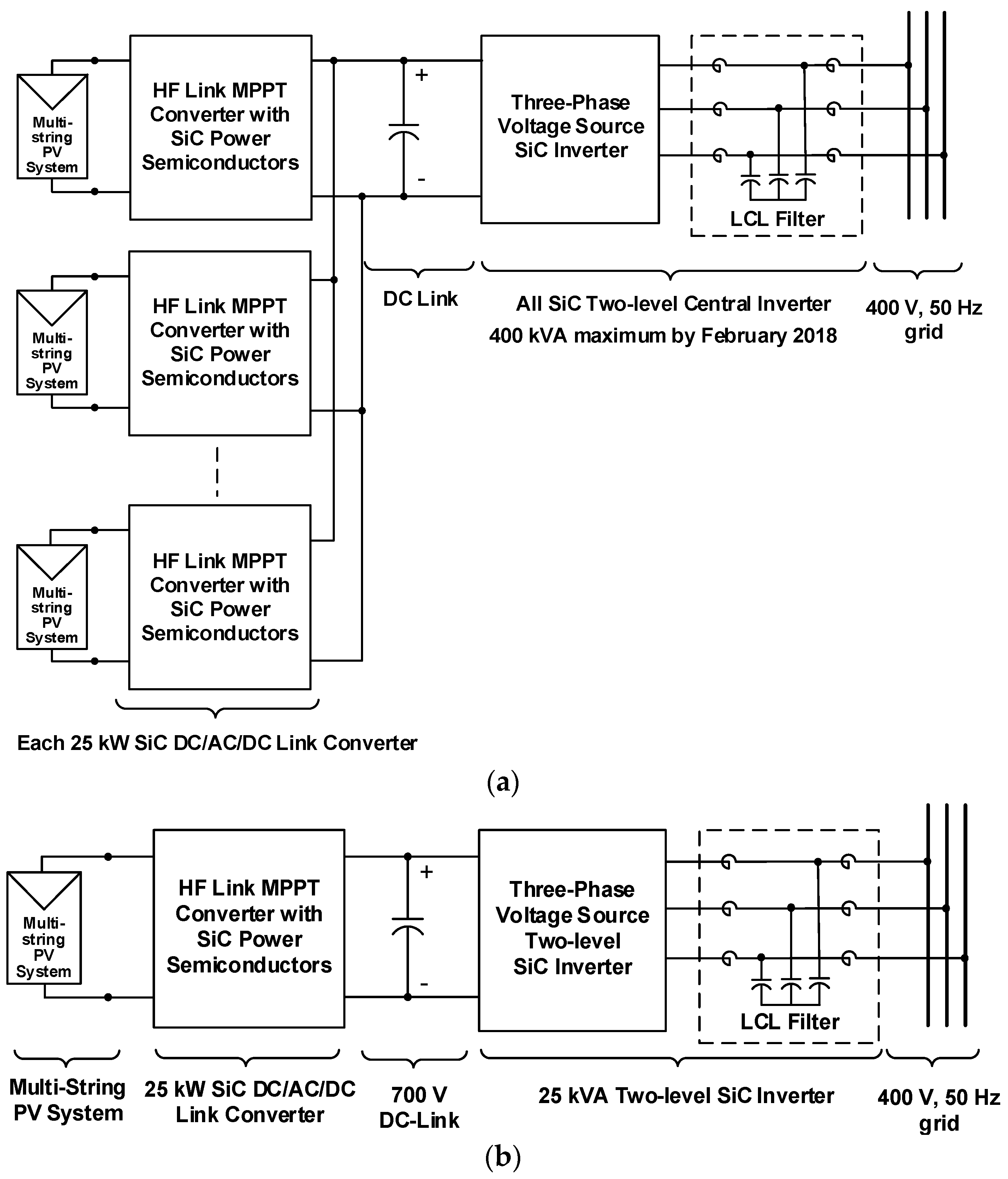
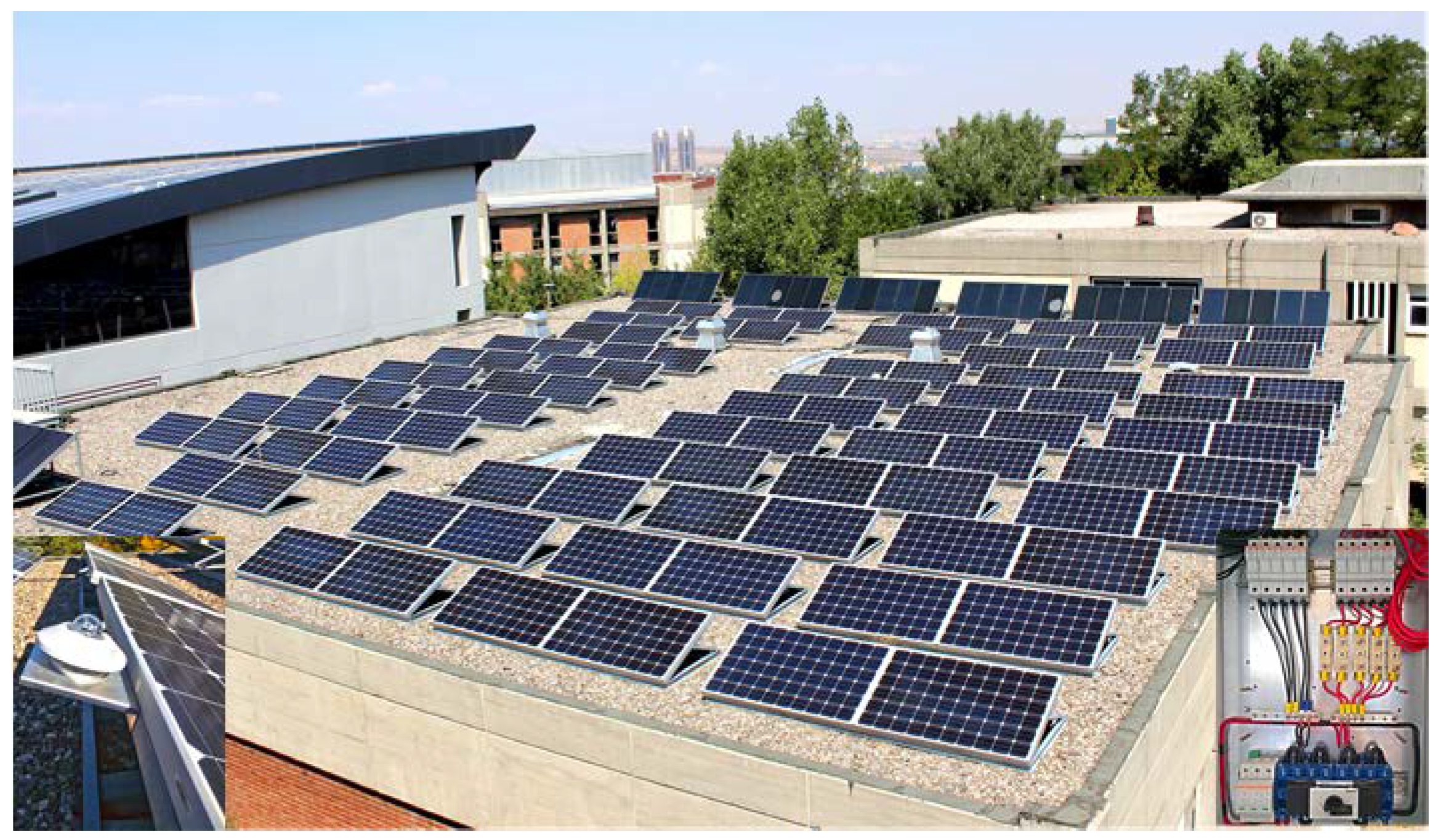
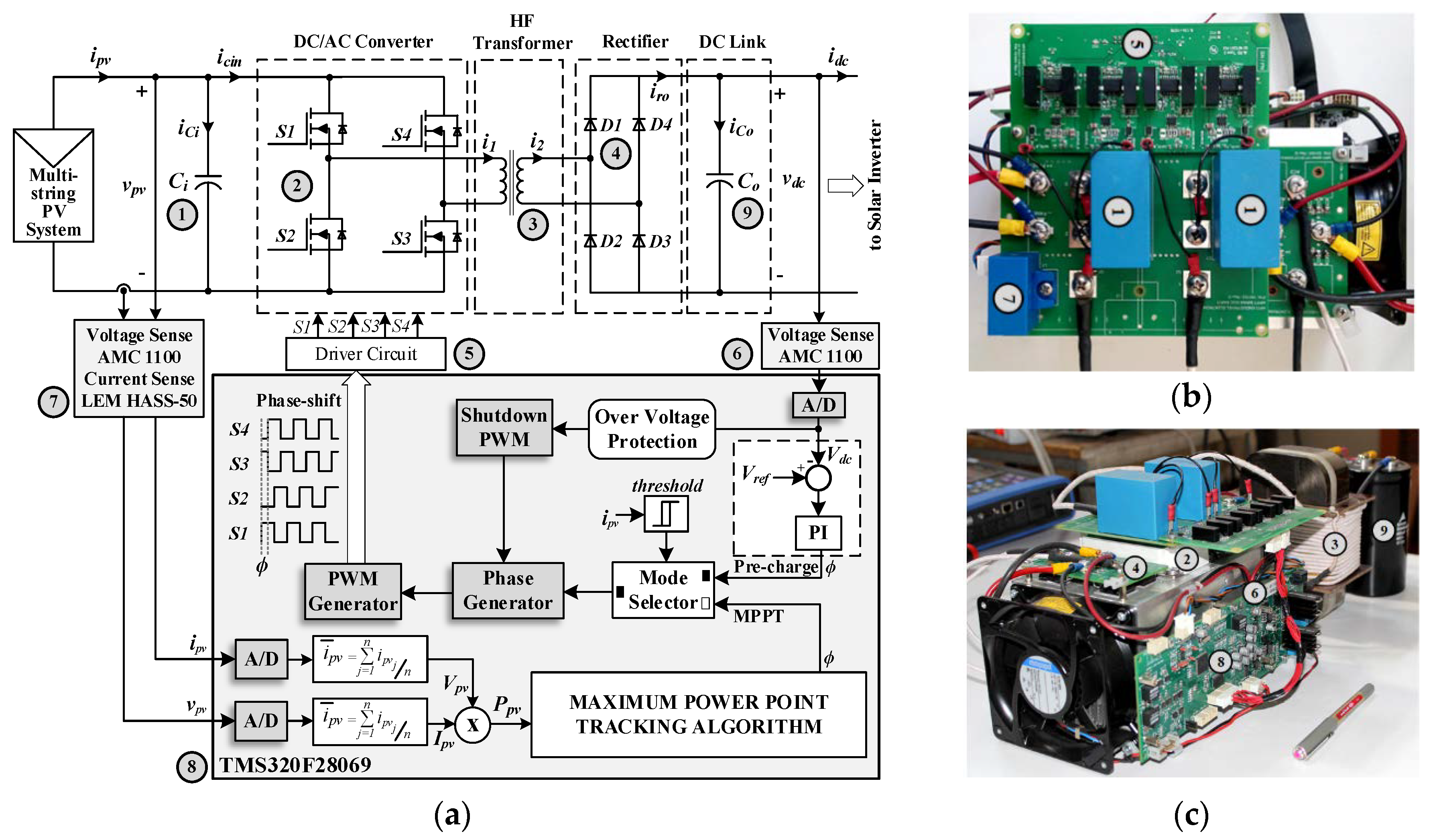
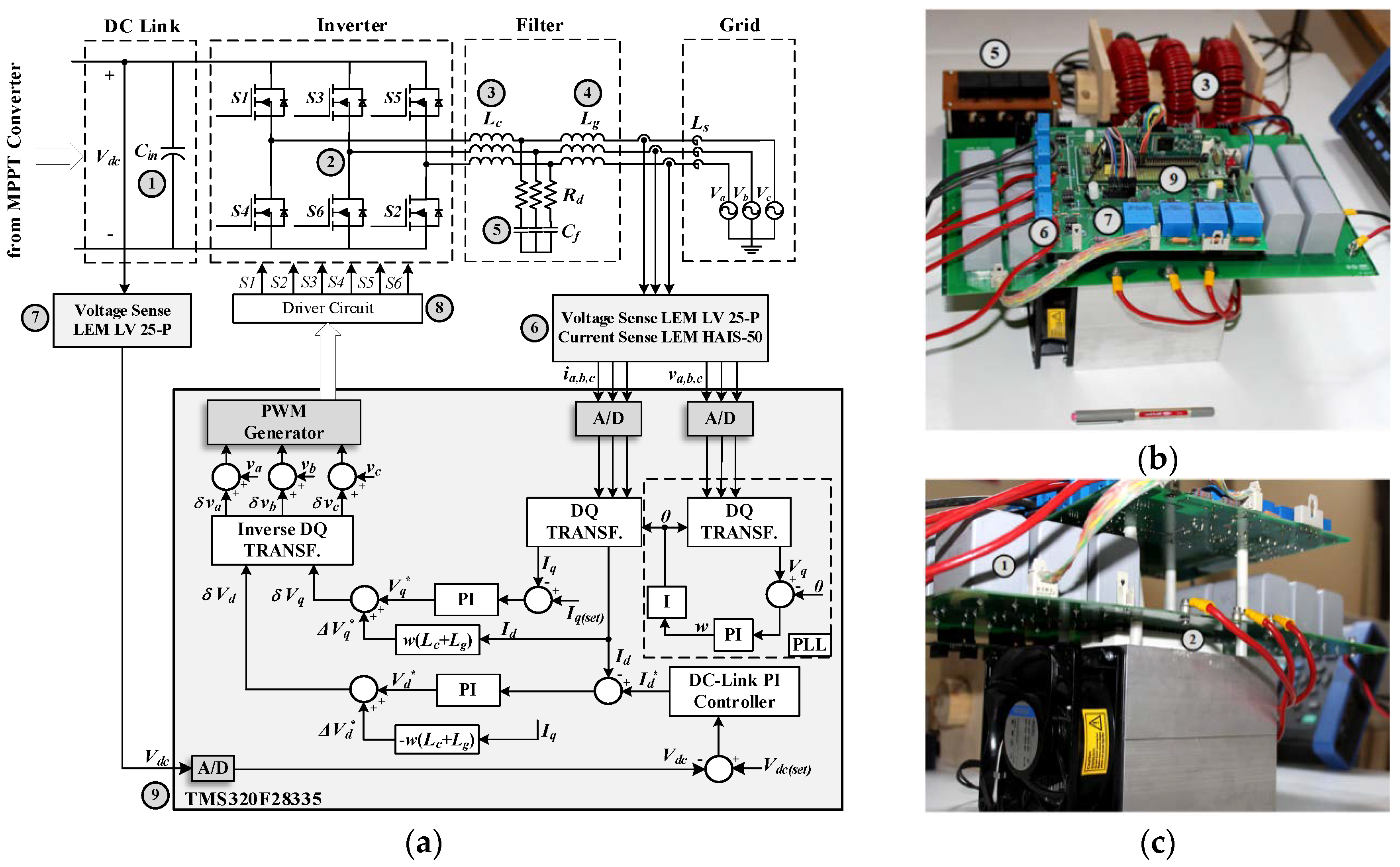

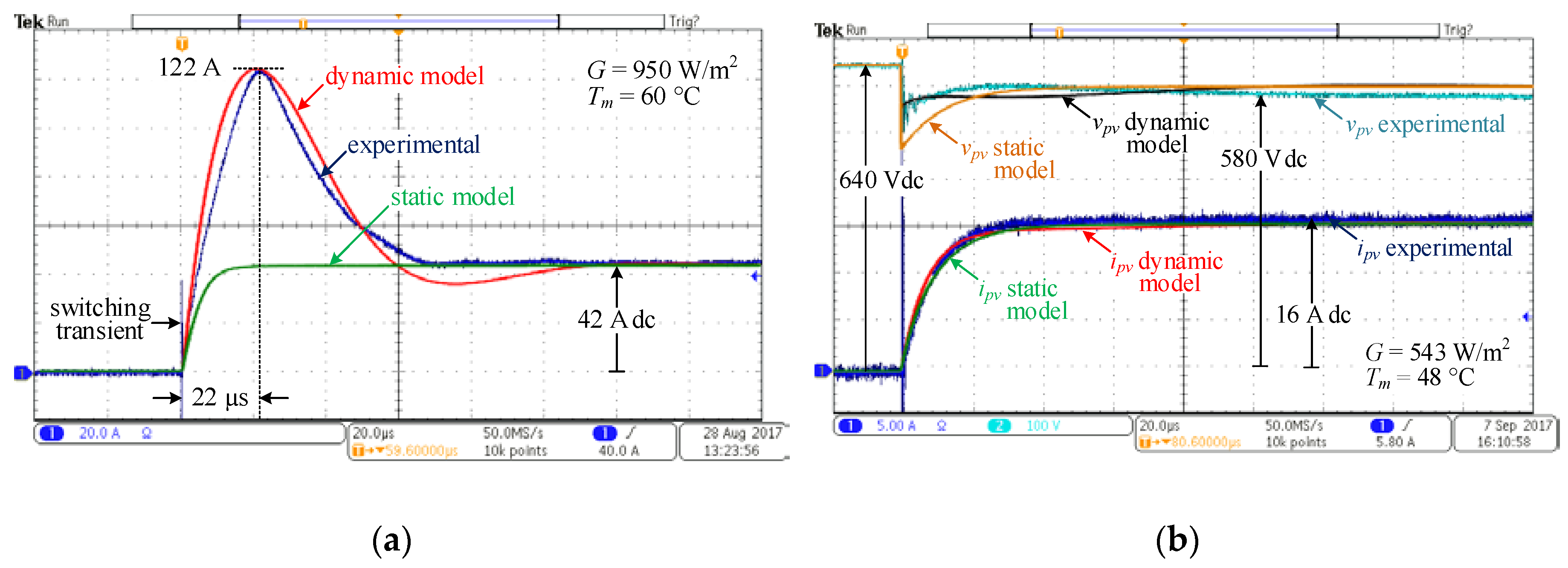


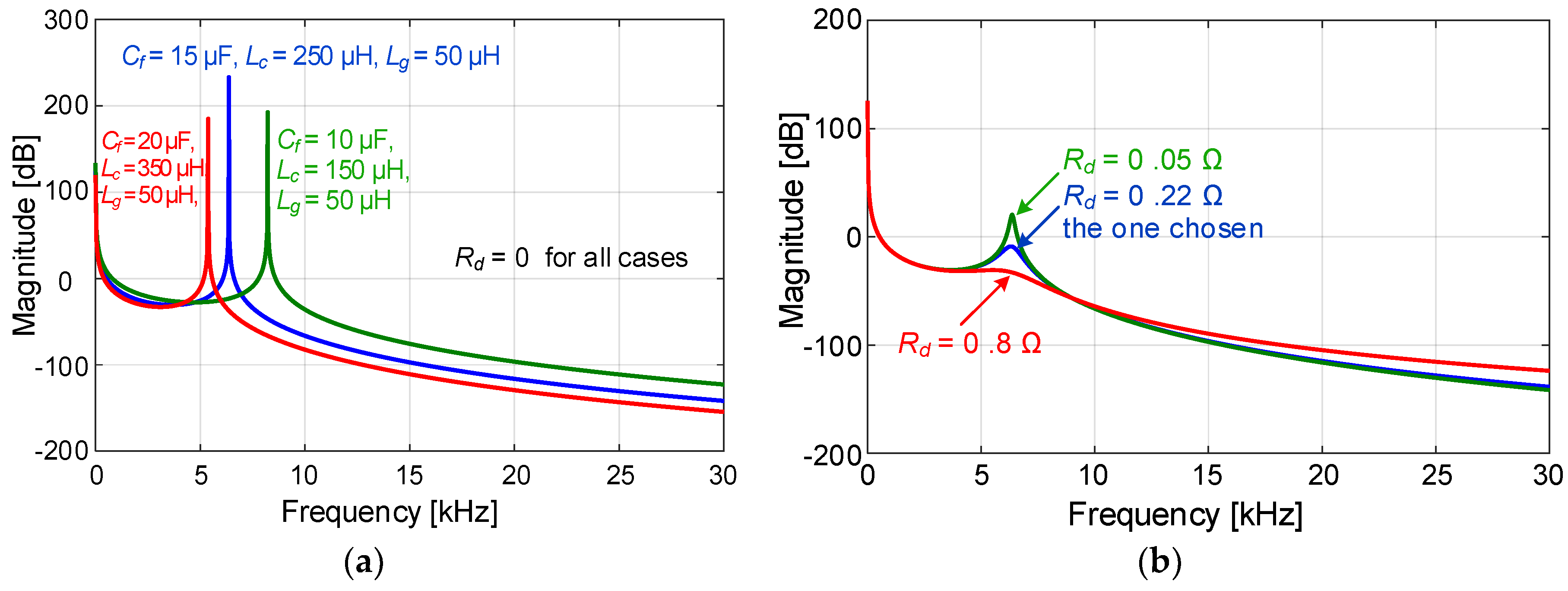

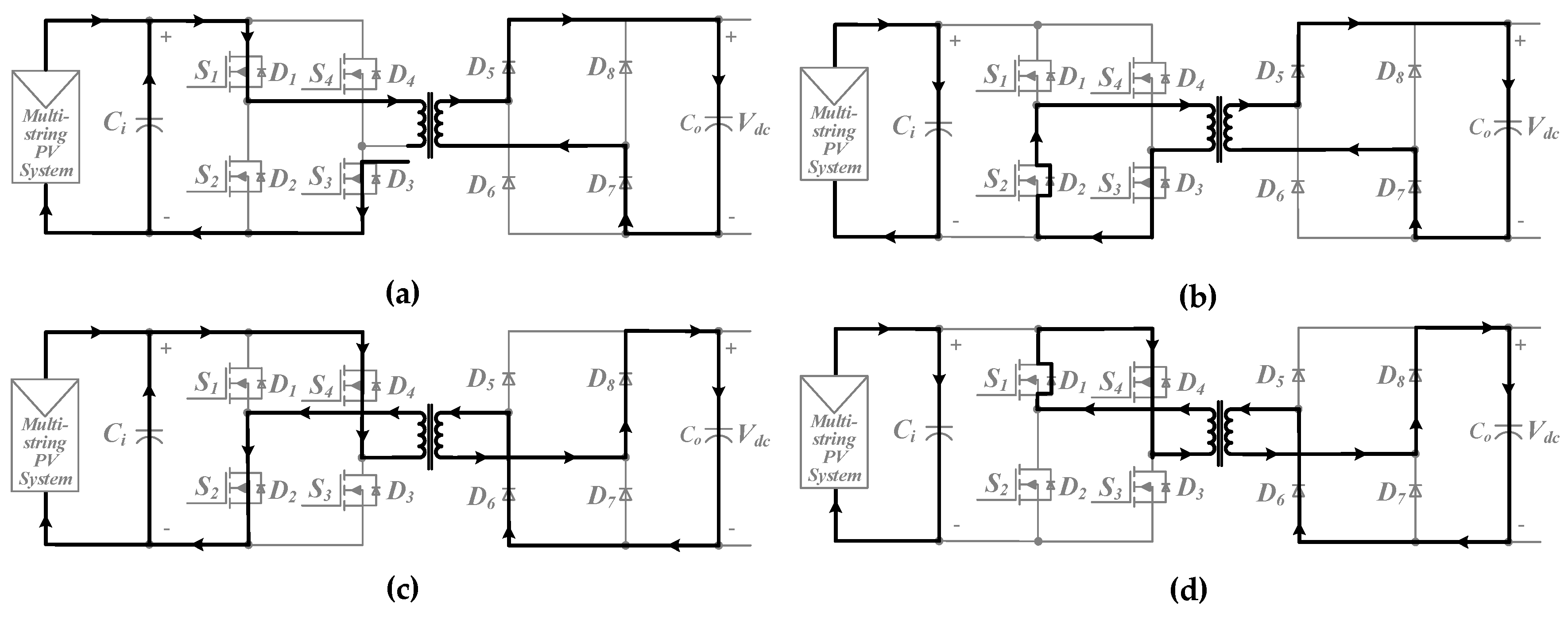
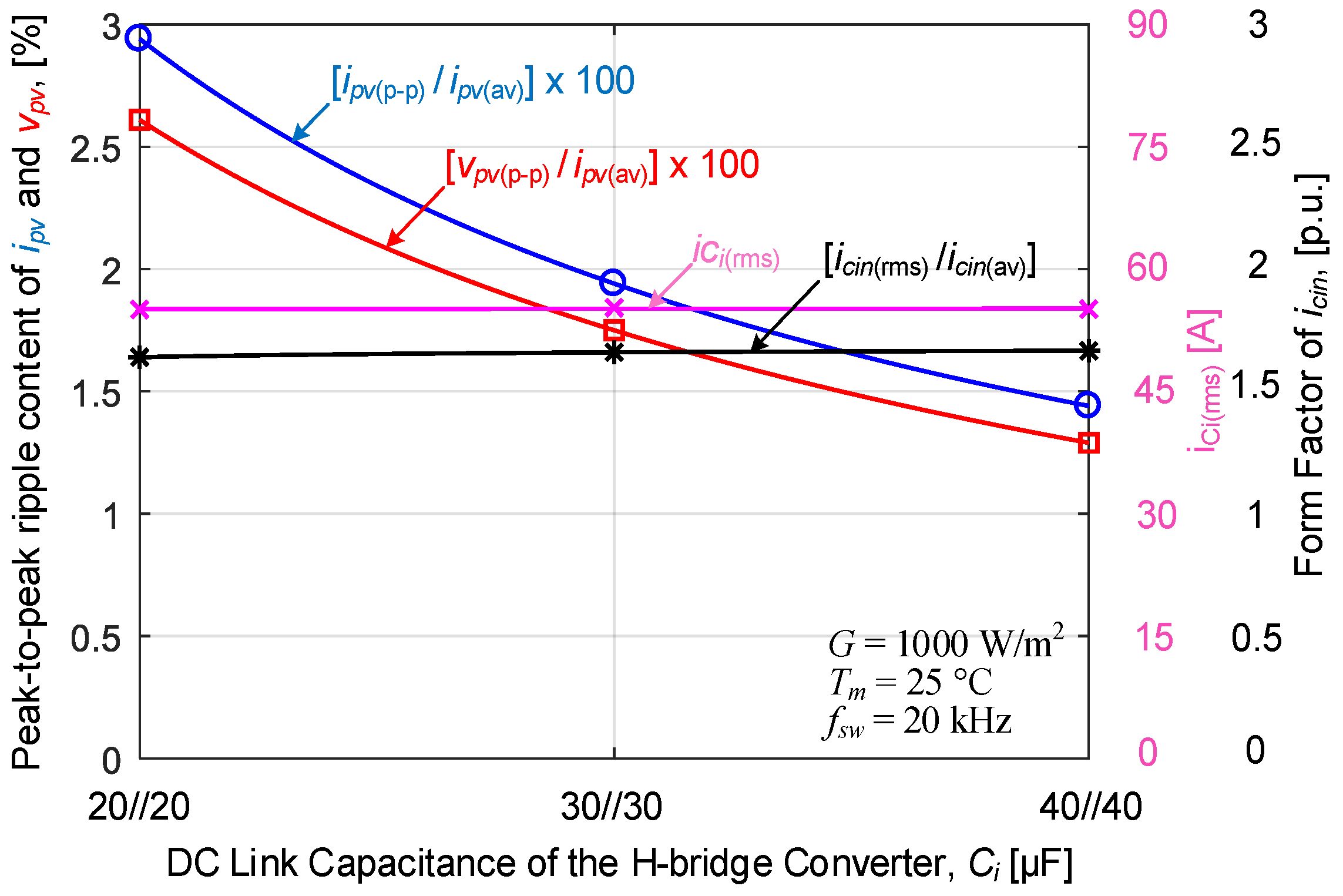
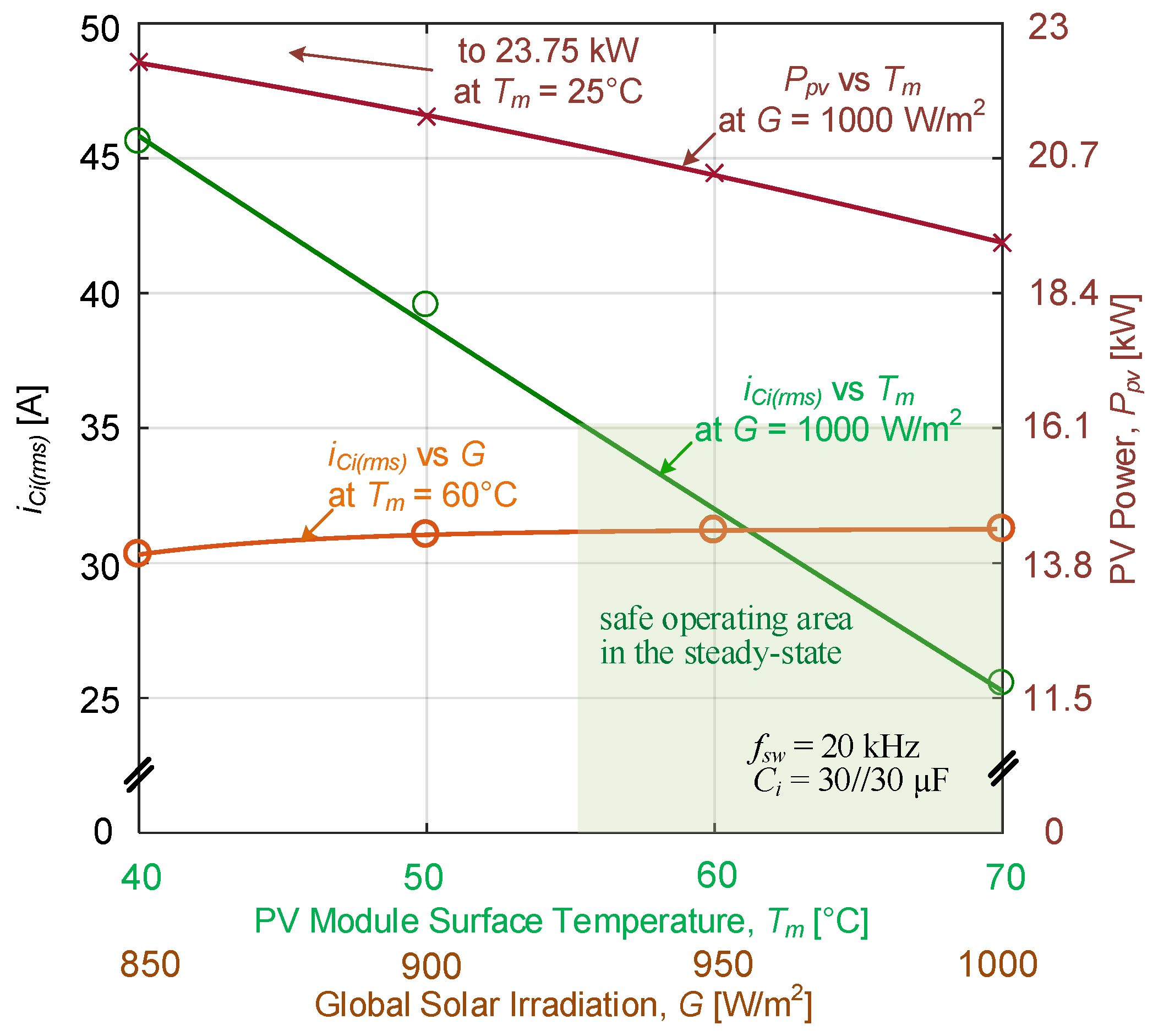
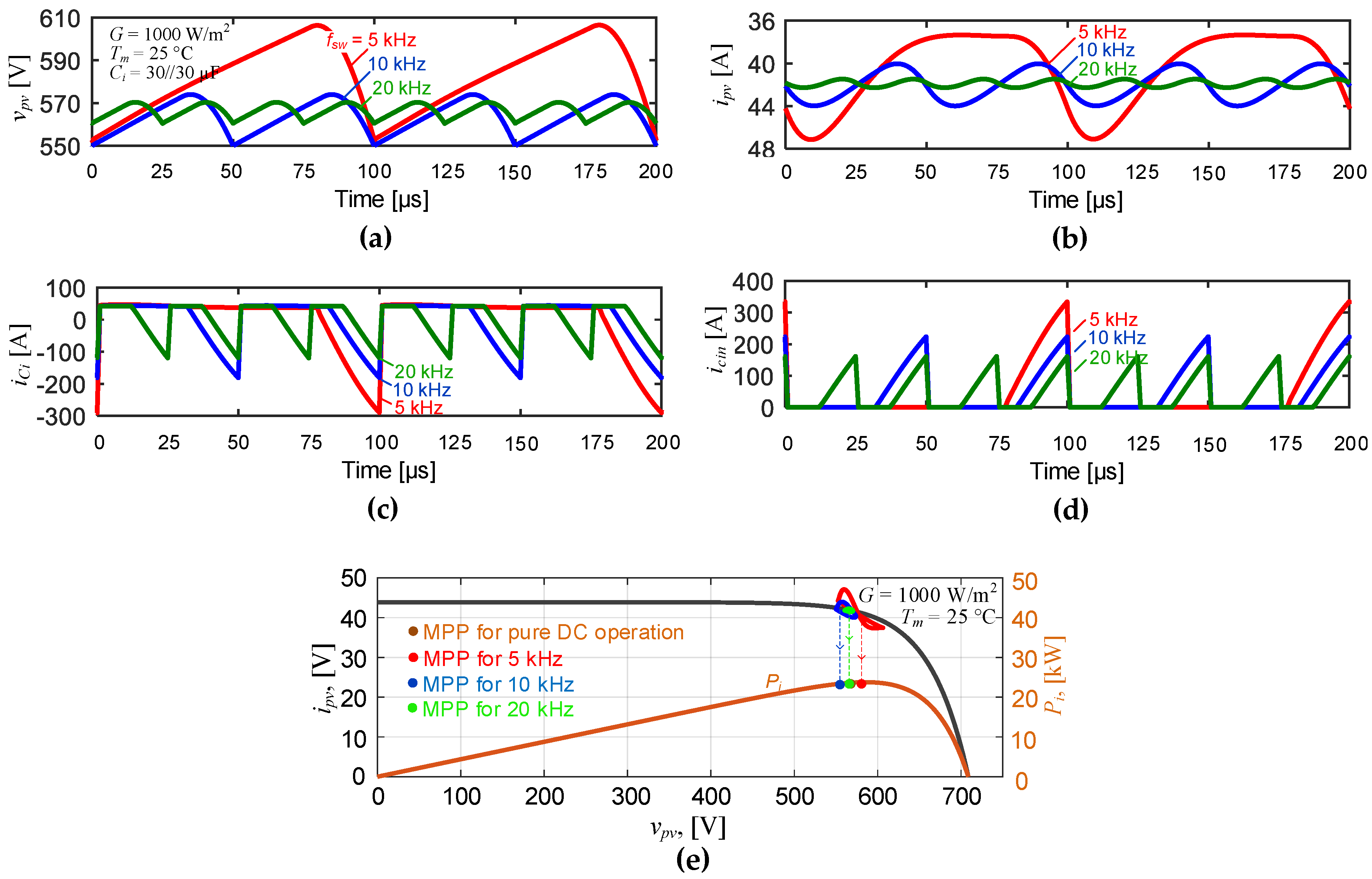
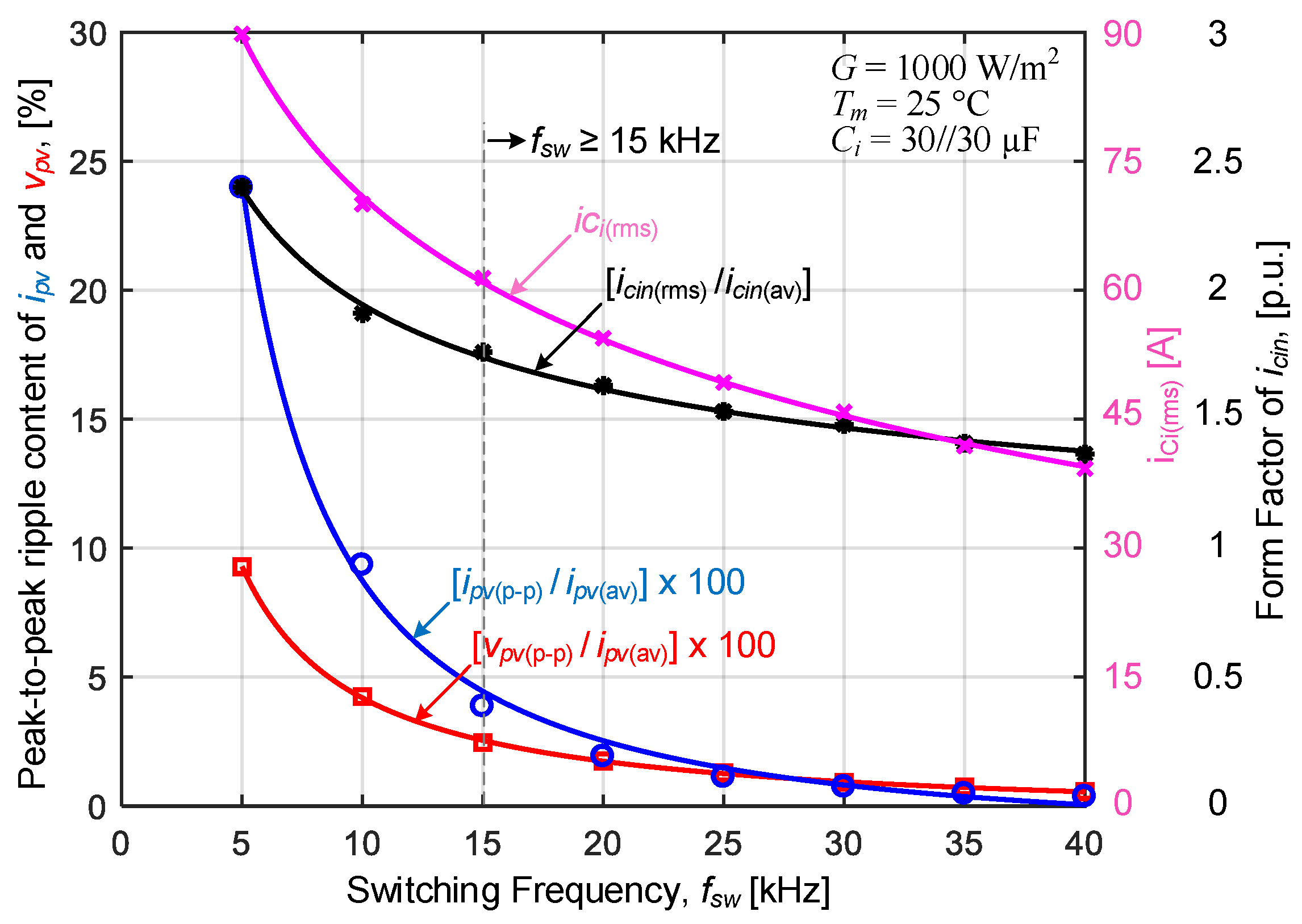
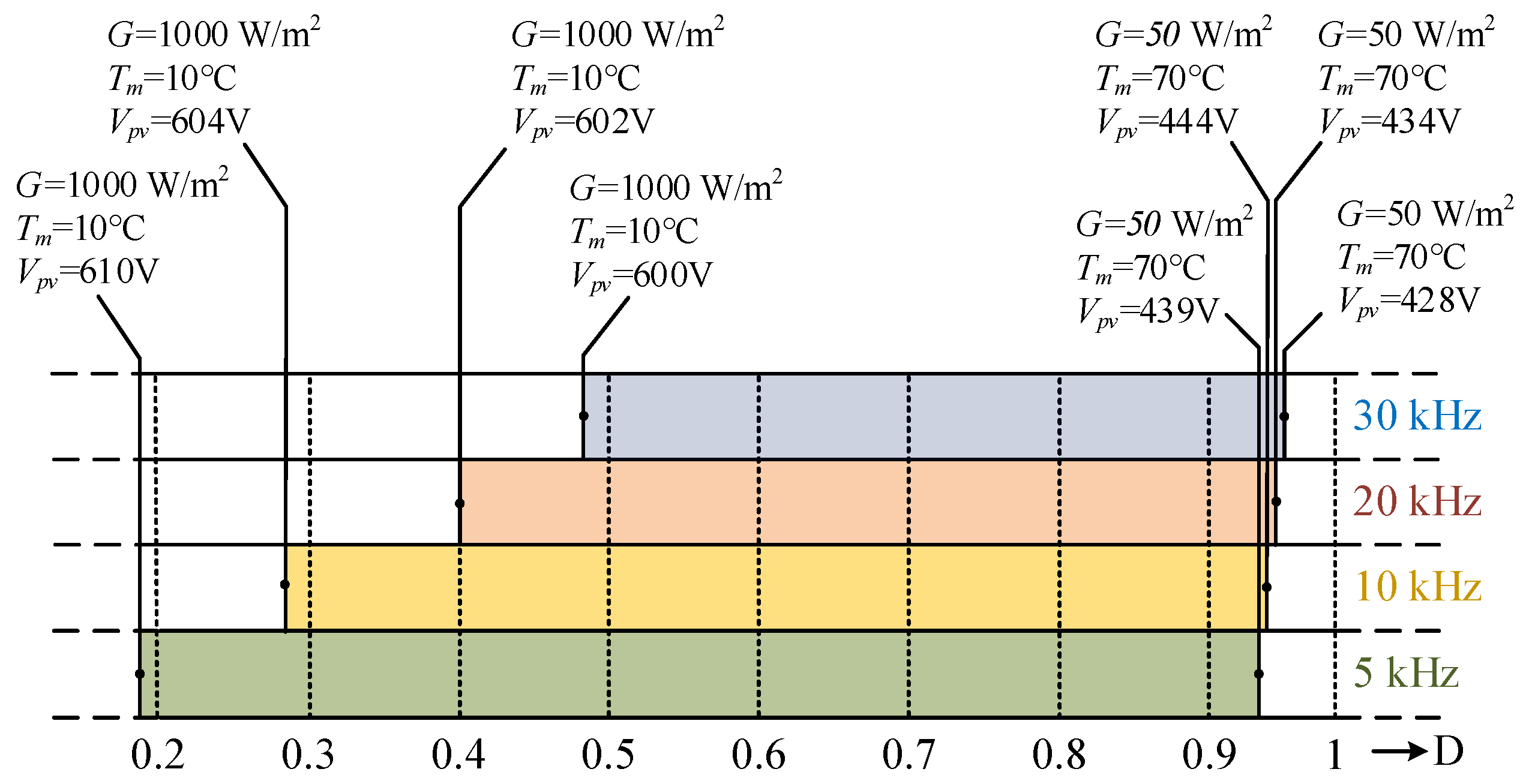
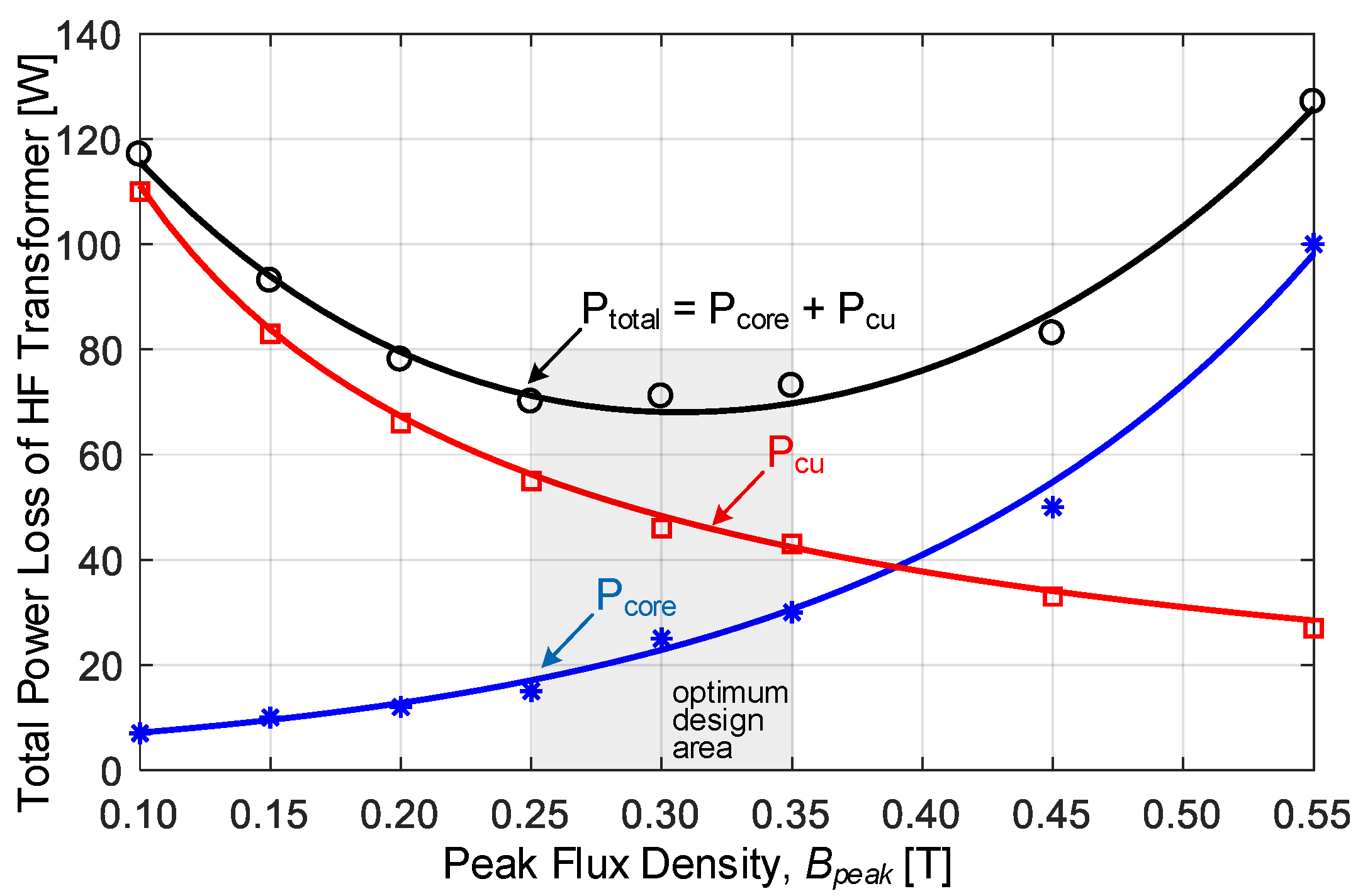


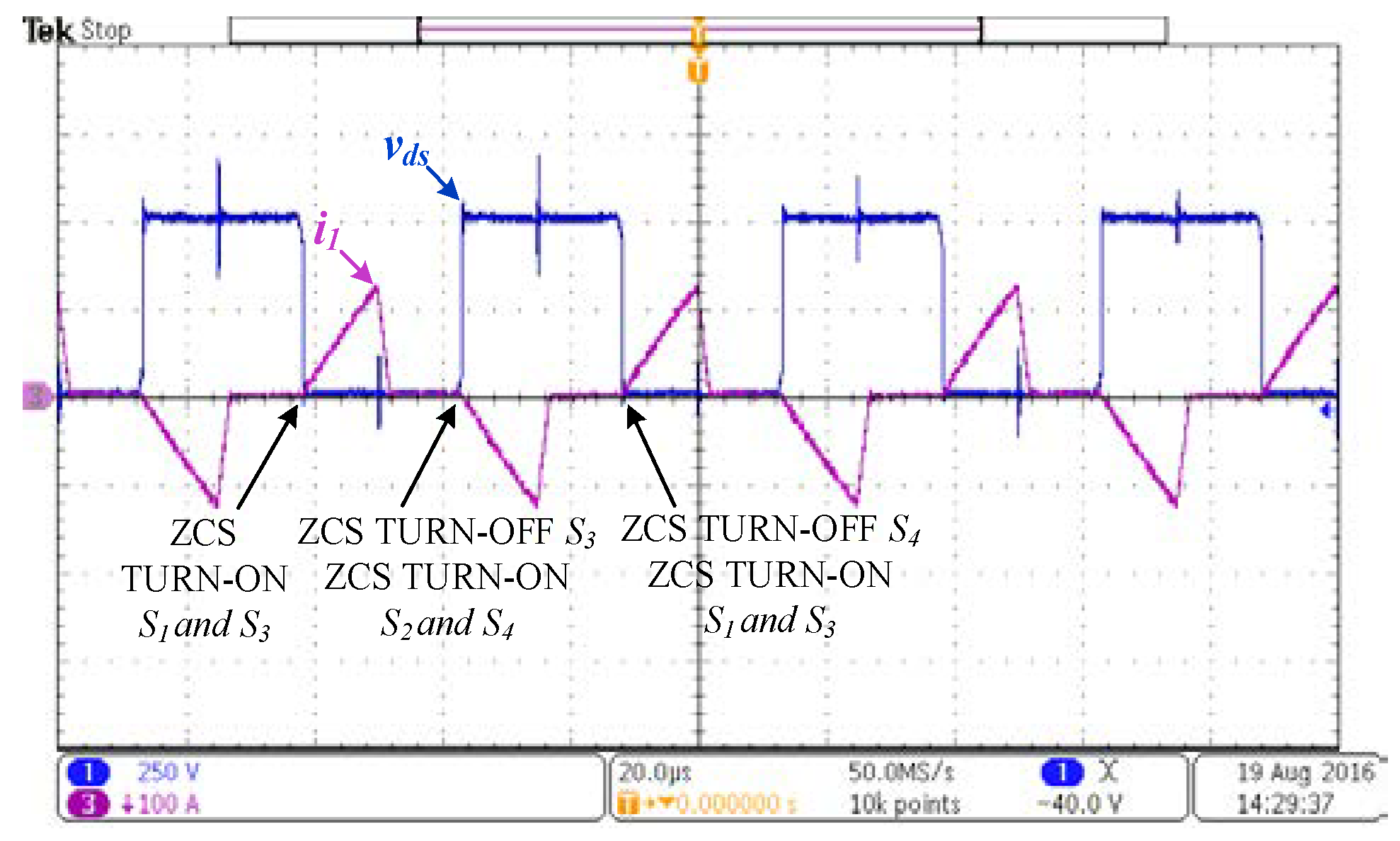

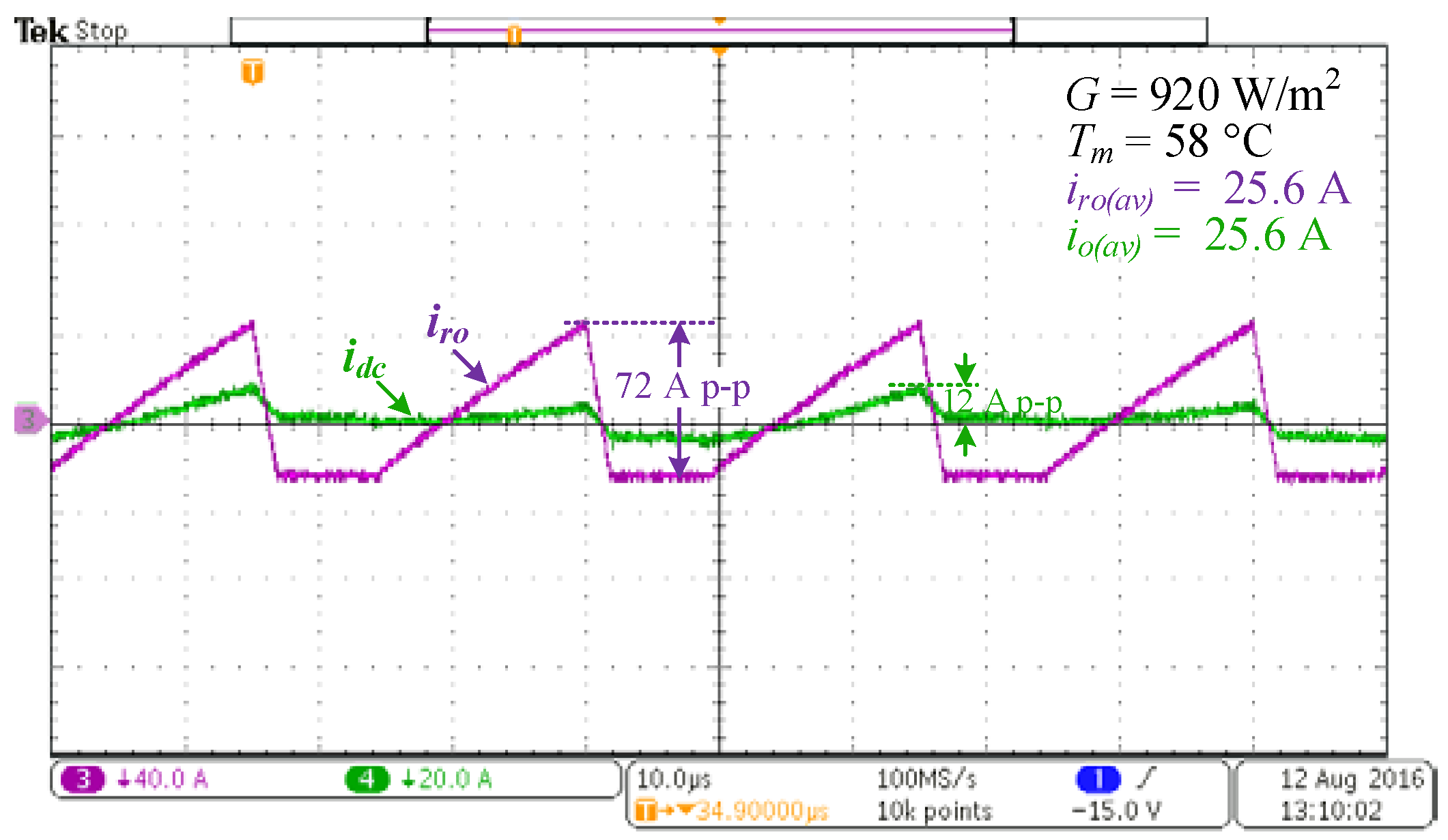
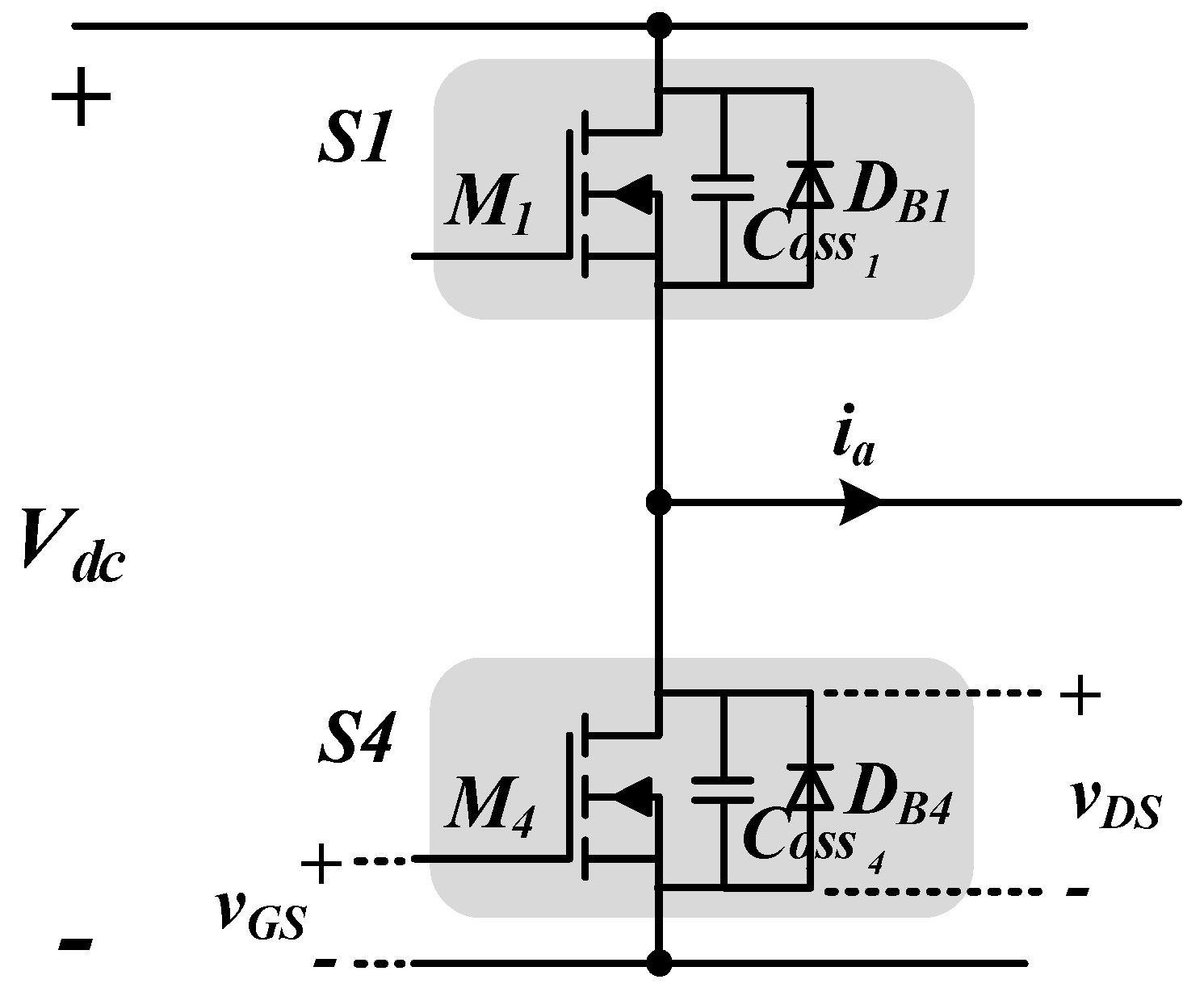
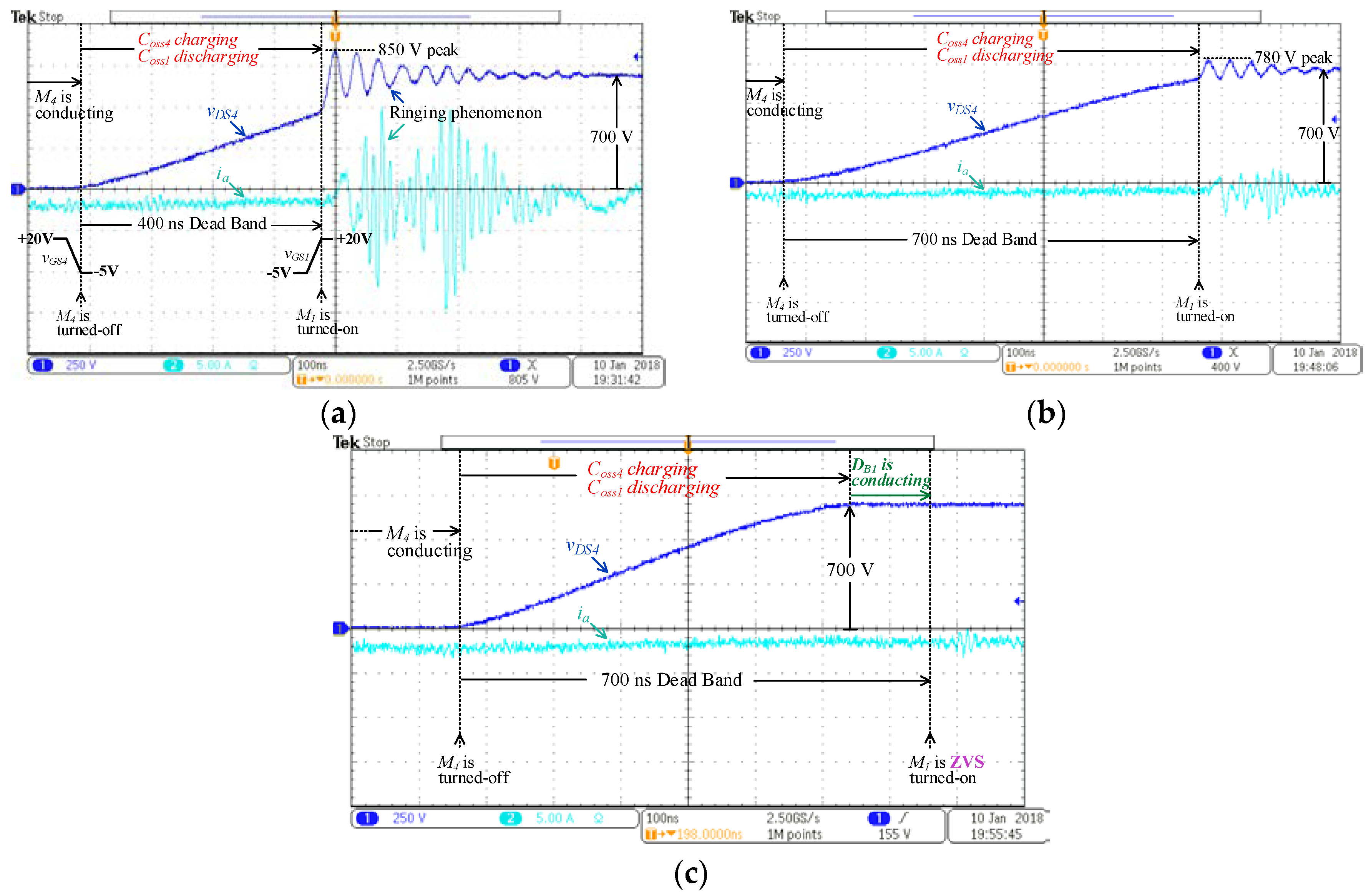
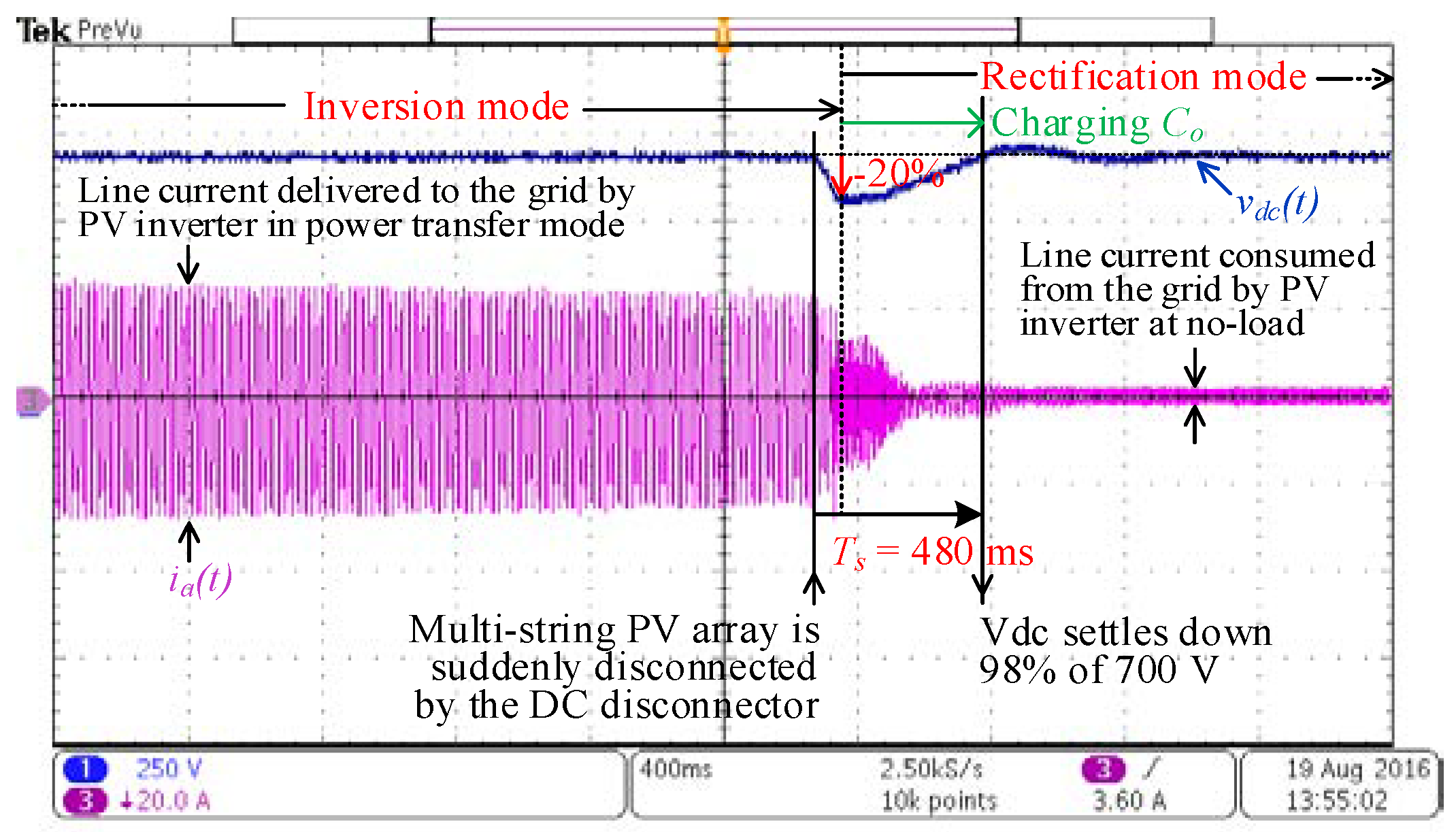
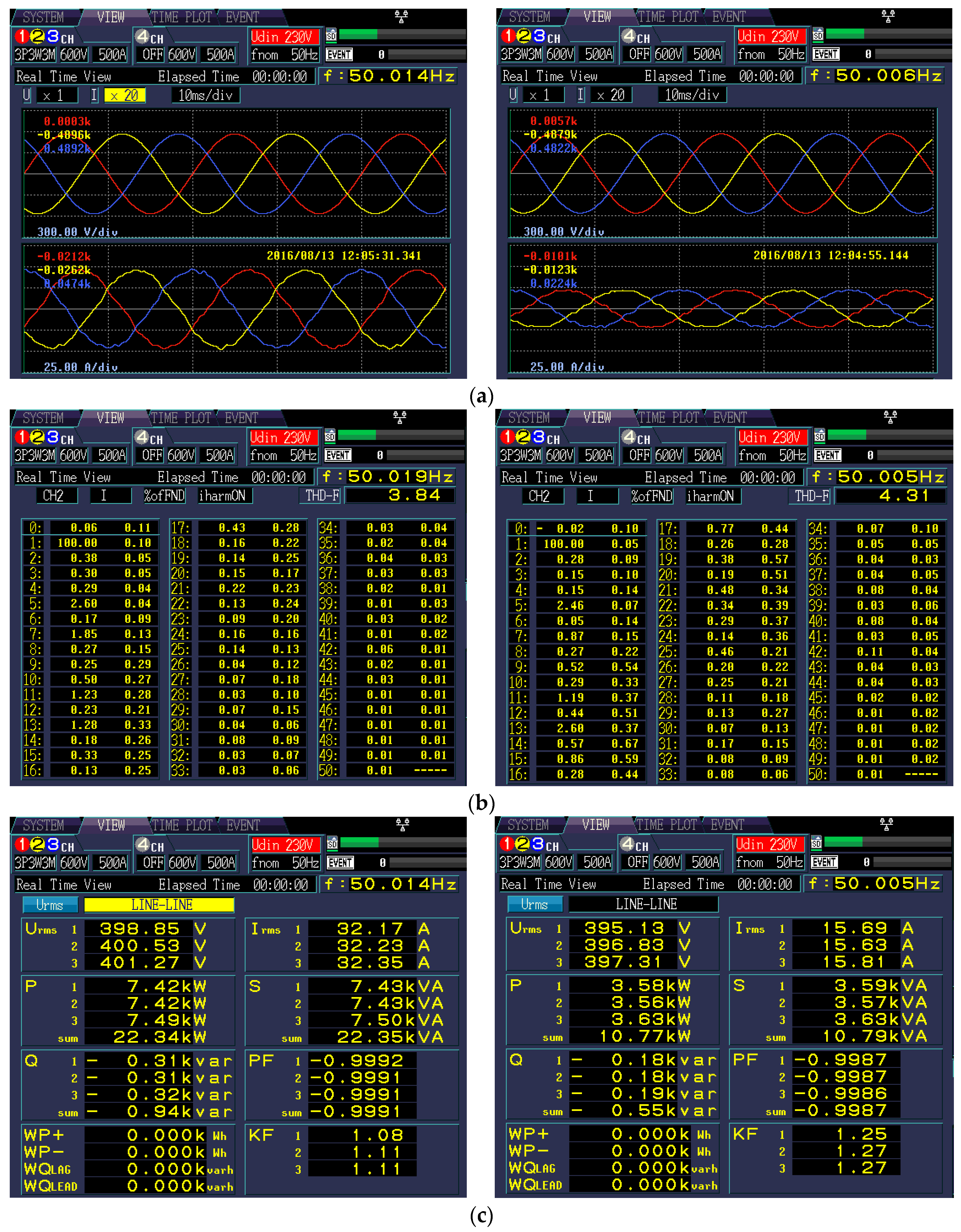
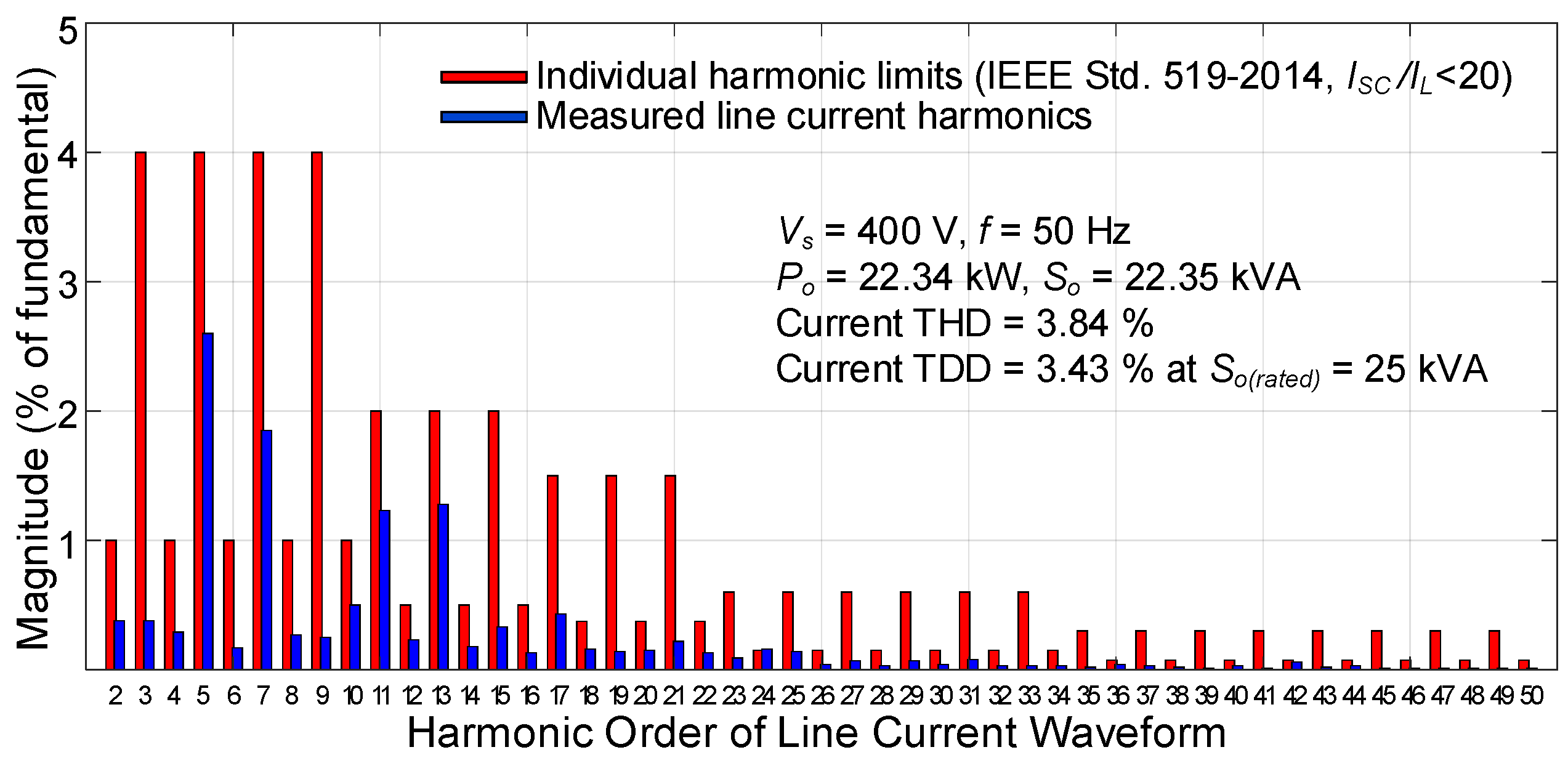
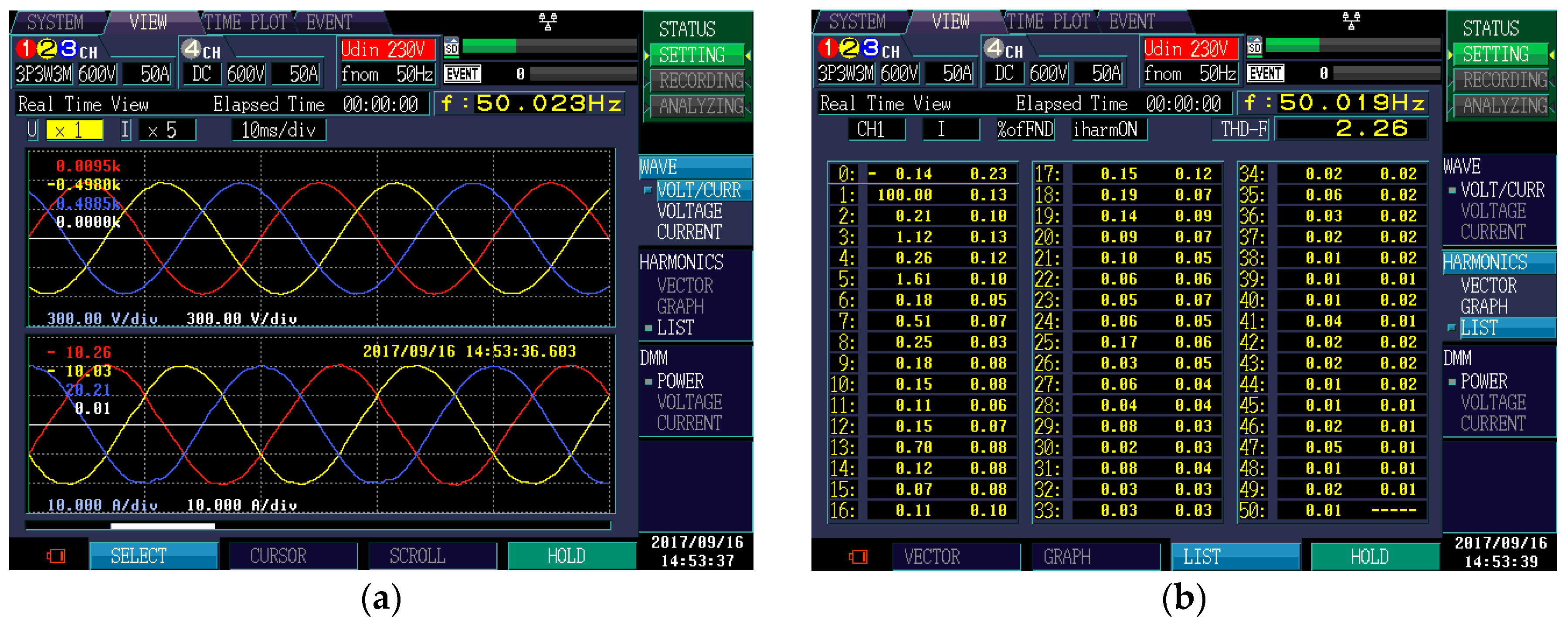

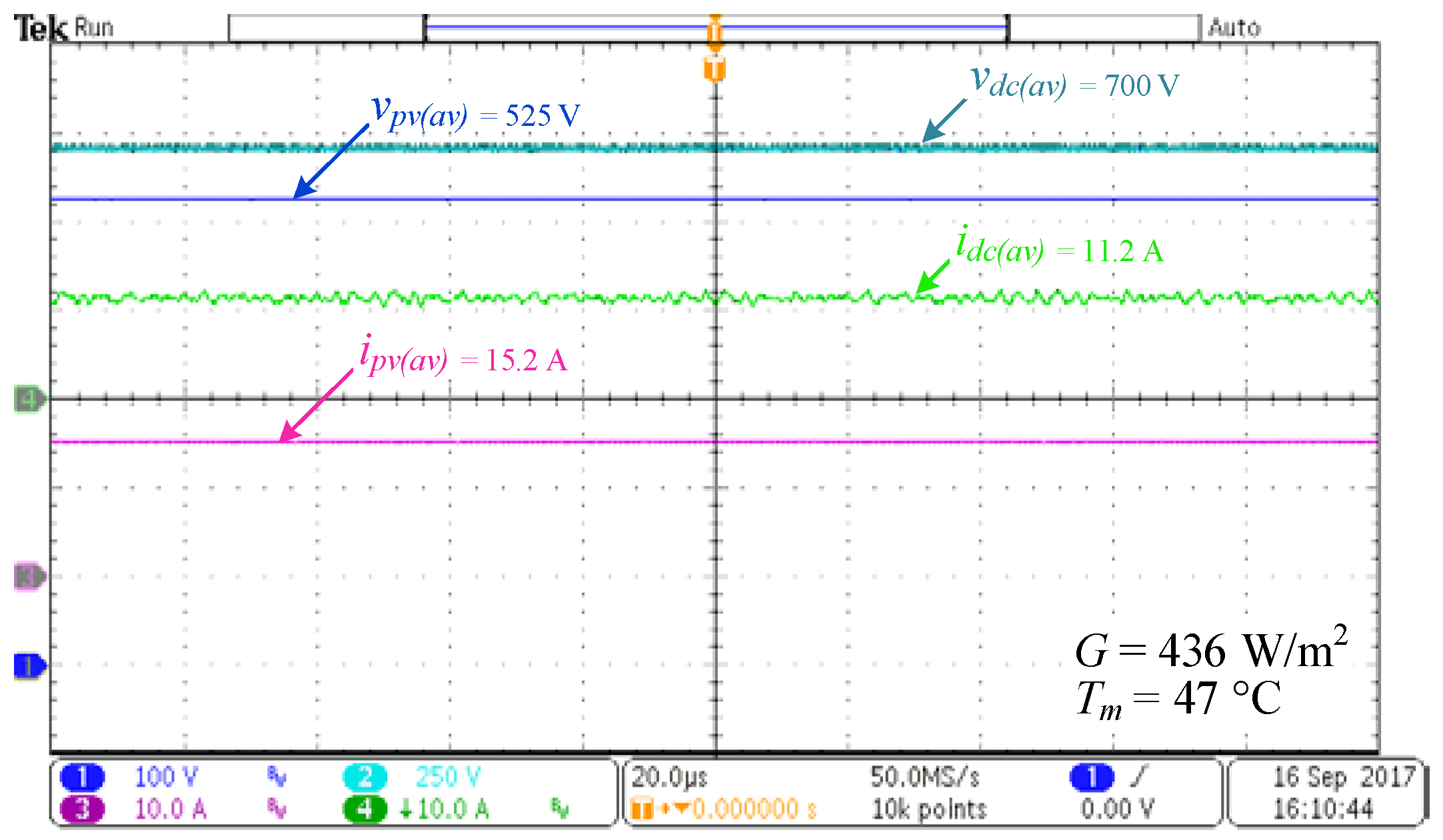
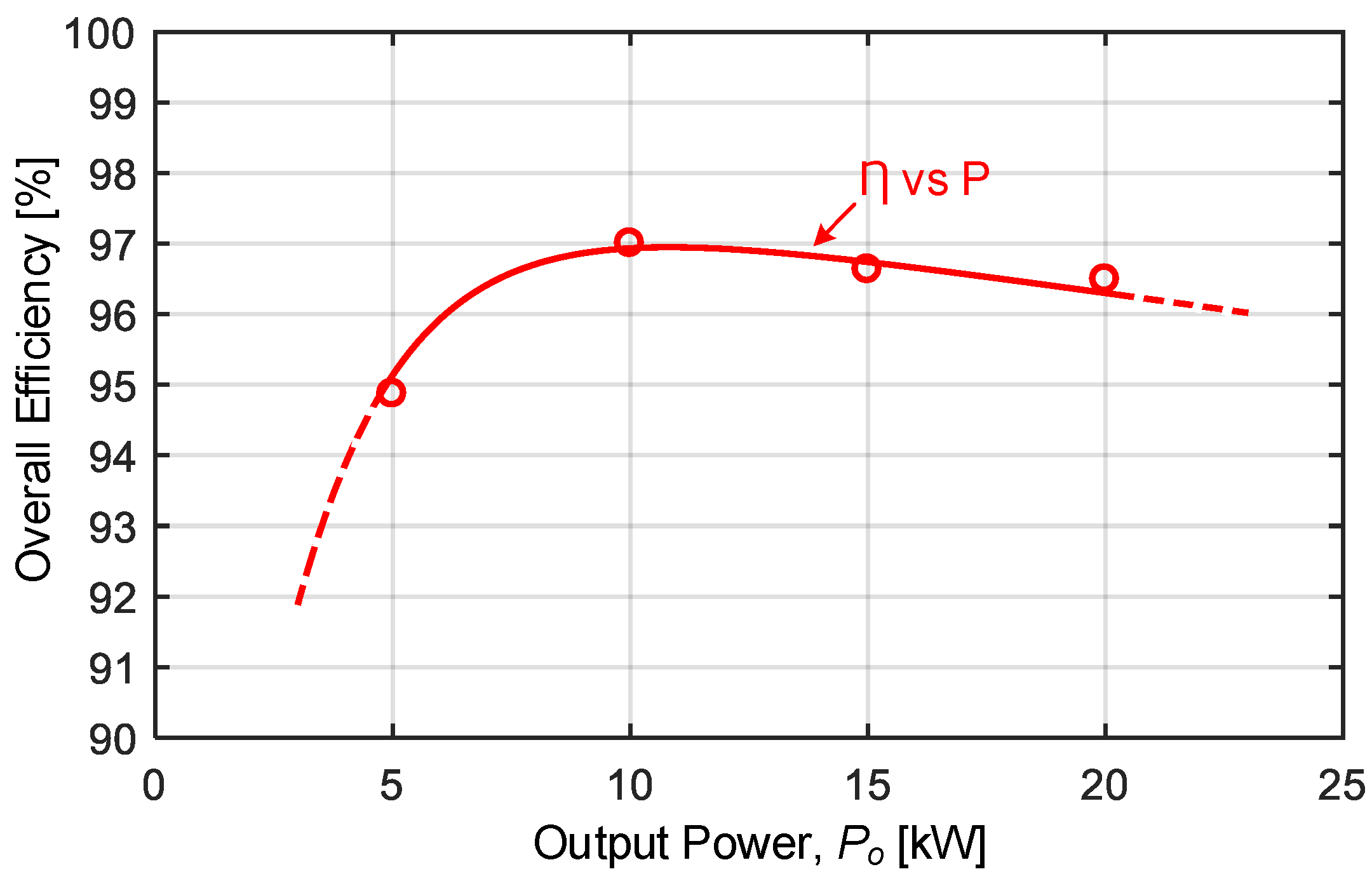
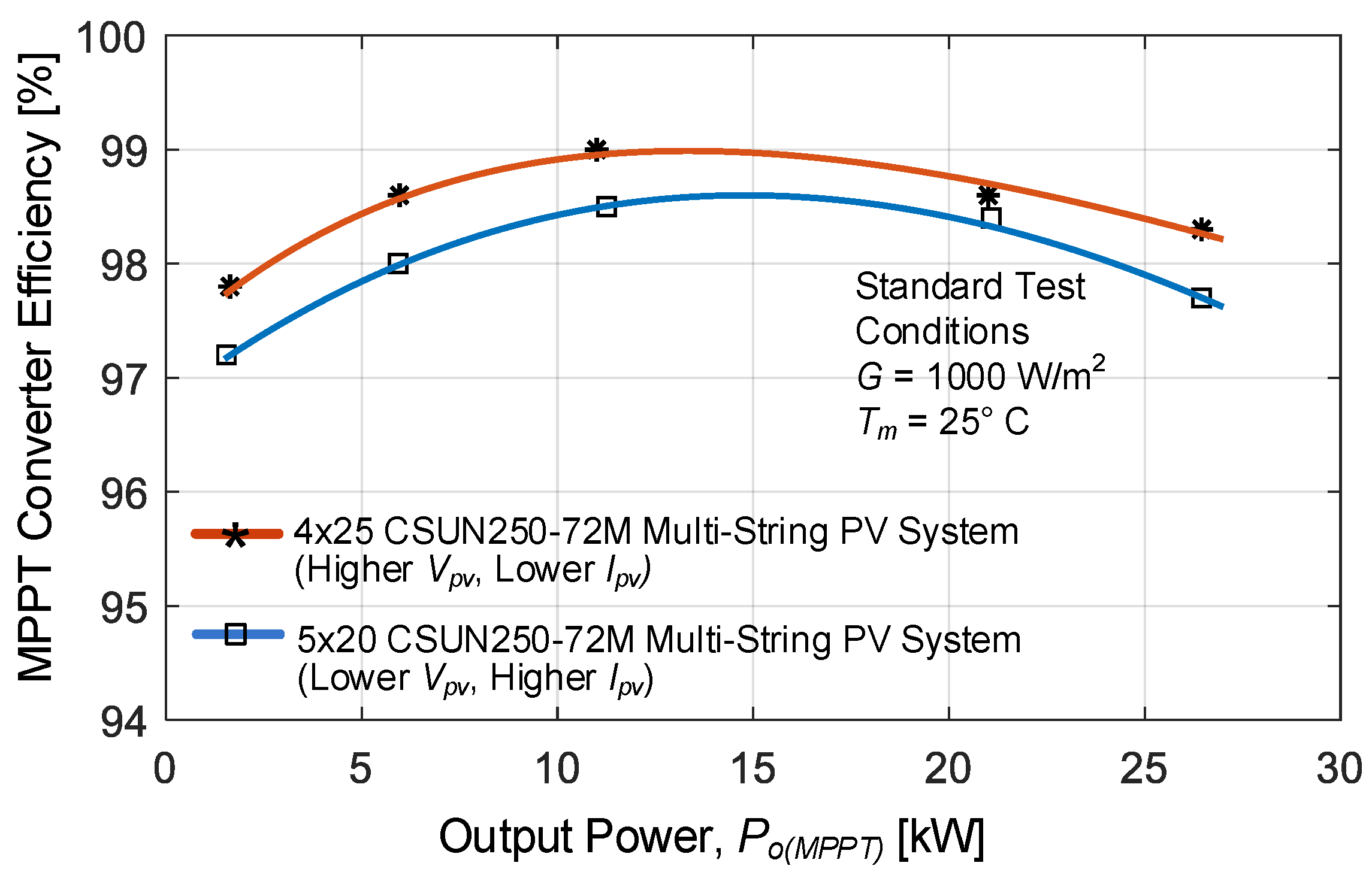
| Manufacturer | Half-Bridge Module | VDS, V | ID, A |
|---|---|---|---|
| ROHM [63] | BSM300D12P2E001 | 1200 | 300 |
| CREE [64] | CAS325M12HM2 | 1200 | 325 |
| SEMIKRON [65] | SKM500MB120SC | 1200 | 541 |
| Mitsubishi [66] | FMF800DX-24A | 1200 | 800 |
| Capacity, μF | Code | I, A rms | ESR, mΩ |
|---|---|---|---|
| 20 | B32778T0206 | 13 | 11.9 |
| 30 | B32778G0306 | 17.5 | 8.2 |
| 40 | B32778G0406 | 21.5 | 6.2 |
| H-Bridge Converter | Diode Bridge Rectifier | Total SiC MOSFET and SiC Diode Losses | |||||
|---|---|---|---|---|---|---|---|
| fsw (kHz) | Ipeak (A) | Irms (A) | Pcond (W) | Psw (W) | Iave (A) | Pcond (W) | Ptotal (W) |
| 5 | 380 | 84 | 452 | 82 | 17.3 | 111 | 645 |
| 10 | 280 | 72 | 332 | 140 | 17.3 | 111 | 583 |
| 20 | 200 | 60 | 230 | 232 | 17.3 | 111 | 573 |
| 30 | 160 | 54 | 187 | 313 | 17.3 | 111 | 611 |
| 40 | 140 | 50 | 160 | 388 | 17.4 | 111 | 659 |
| Test Condition * | Pi, kW | Po(MPPT), kW | Efficiency, ƞ = [Po(MPPT)/Pi] 100, % | |||
|---|---|---|---|---|---|---|
| G and Tm | Experimental * | Theoretical † | Experimental * | Theoretical ° | Experimental | Theoretical |
| G = 70 W/m2 Tm = 32 °C | 1.66 | 1.60 | 1.49 | 1.55 | 89.76 | 93.47 |
| G = 150 W/m2 Tm = 35 °C | 3.28 | 3.14 | 3.08 | 3.13 | 93.90 | 95.55 |
| G = 250 W/m2 Tm = 38 °C | 4.51 | 5.19 | 4.32 | 5.01 | 95.78 | 96.69 |
| G = 370 W/m2 Tm = 40 °C | 8.91 | 8.23 | 8.70 | 8.04 | 97.64 | 97.69 |
| G = 490 W/m2 Tm = 49 °C | 10.61 | 10.21 | 10.37 | 10.02 | 97.73 | 98.20 |
| G = 730 W/m2 Tm = 57 °C | 15.52 | 15.42 | 15.14 | 15.04 | 97.55 | 97.56 |
| G = 980 W/m2 Tm = 60 °C | 20.14 | 20.61 | 19.59 | 20.05 | 97.26 | 97.28 |
| Po(MPPT), kW | Po, kW | Efficiency, ƞ = [Po/Po(MPPT)] 100, % | ||
|---|---|---|---|---|
| Experimental * | Experimental * | Theoretical † | Experimental | Theoretical |
| 3.08 | 2.99 | 3.05 | 97.05 | 99.00 |
| 4.31 | 4.21 | 4.27 | 97.54 | 99.05 |
| 8.69 | 8.57 | 8.61 | 98.55 | 99.10 |
| 10.37 | 10.21 | 10.27 | 98.46 | 99.10 |
| 15.13 | 14.88 | 14.98 | 98.32 | 99.05 |
| 19.58 | 19.21 | 19.38 | 98.09 | 99.00 |
© 2018 by the authors. Licensee MDPI, Basel, Switzerland. This article is an open access article distributed under the terms and conditions of the Creative Commons Attribution (CC BY) license (http://creativecommons.org/licenses/by/4.0/).
Share and Cite
Öztürk, S.; Canver, M.; Çadırcı, I.; Ermiş, M. All SiC Grid-Connected PV Supply with HF Link MPPT Converter: System Design Methodology and Development of a 20 kHz, 25 kVA Prototype. Electronics 2018, 7, 85. https://doi.org/10.3390/electronics7060085
Öztürk S, Canver M, Çadırcı I, Ermiş M. All SiC Grid-Connected PV Supply with HF Link MPPT Converter: System Design Methodology and Development of a 20 kHz, 25 kVA Prototype. Electronics. 2018; 7(6):85. https://doi.org/10.3390/electronics7060085
Chicago/Turabian StyleÖztürk, Serkan, Mehmet Canver, Işık Çadırcı, and Muammer Ermiş. 2018. "All SiC Grid-Connected PV Supply with HF Link MPPT Converter: System Design Methodology and Development of a 20 kHz, 25 kVA Prototype" Electronics 7, no. 6: 85. https://doi.org/10.3390/electronics7060085
APA StyleÖztürk, S., Canver, M., Çadırcı, I., & Ermiş, M. (2018). All SiC Grid-Connected PV Supply with HF Link MPPT Converter: System Design Methodology and Development of a 20 kHz, 25 kVA Prototype. Electronics, 7(6), 85. https://doi.org/10.3390/electronics7060085




